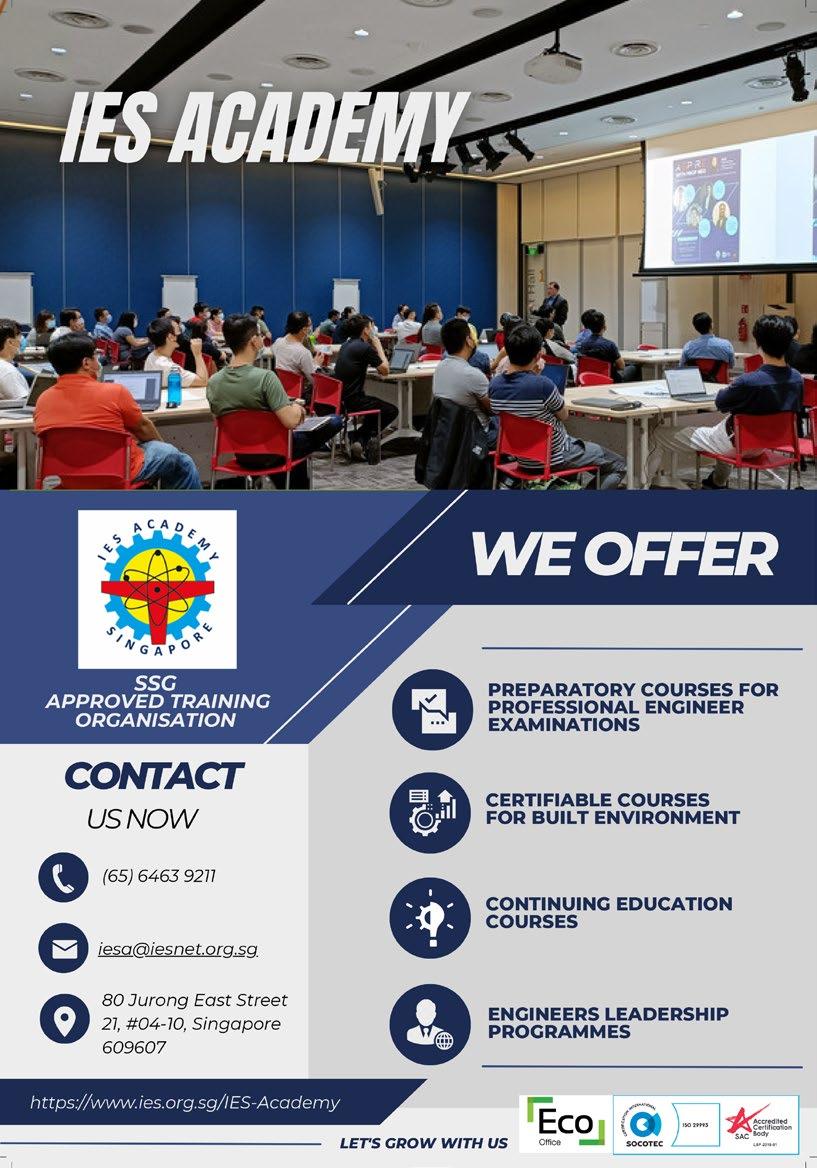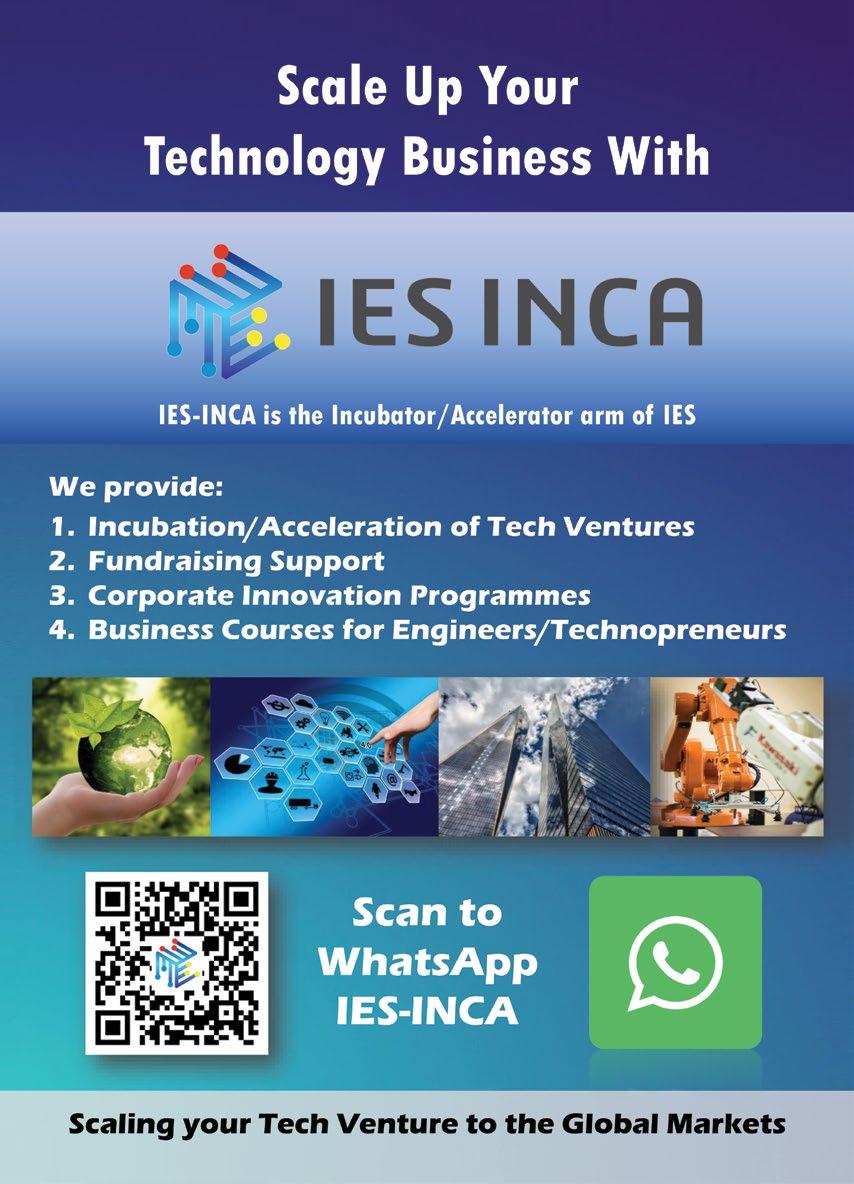
www.ies.org.sg



www.ies.org.sg

APRIL 2024 MCI (P) 002/03/2024
SUSTAINABILITY: Surbana Jurong opens new global headquarters
ENERGY ENGINEERING: The importance of energy conservation
AEROSPACE ENGINEERING: Singapore Sustainable Air Hub Blueprint launched
COVER STORY: Singapore scientists develop revolutionary microelectronic device


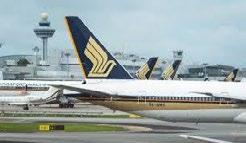
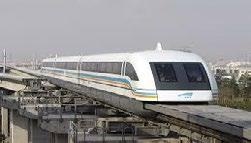


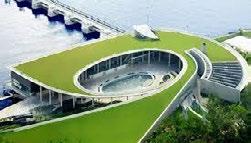

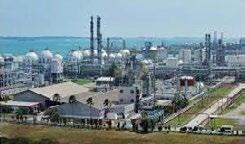


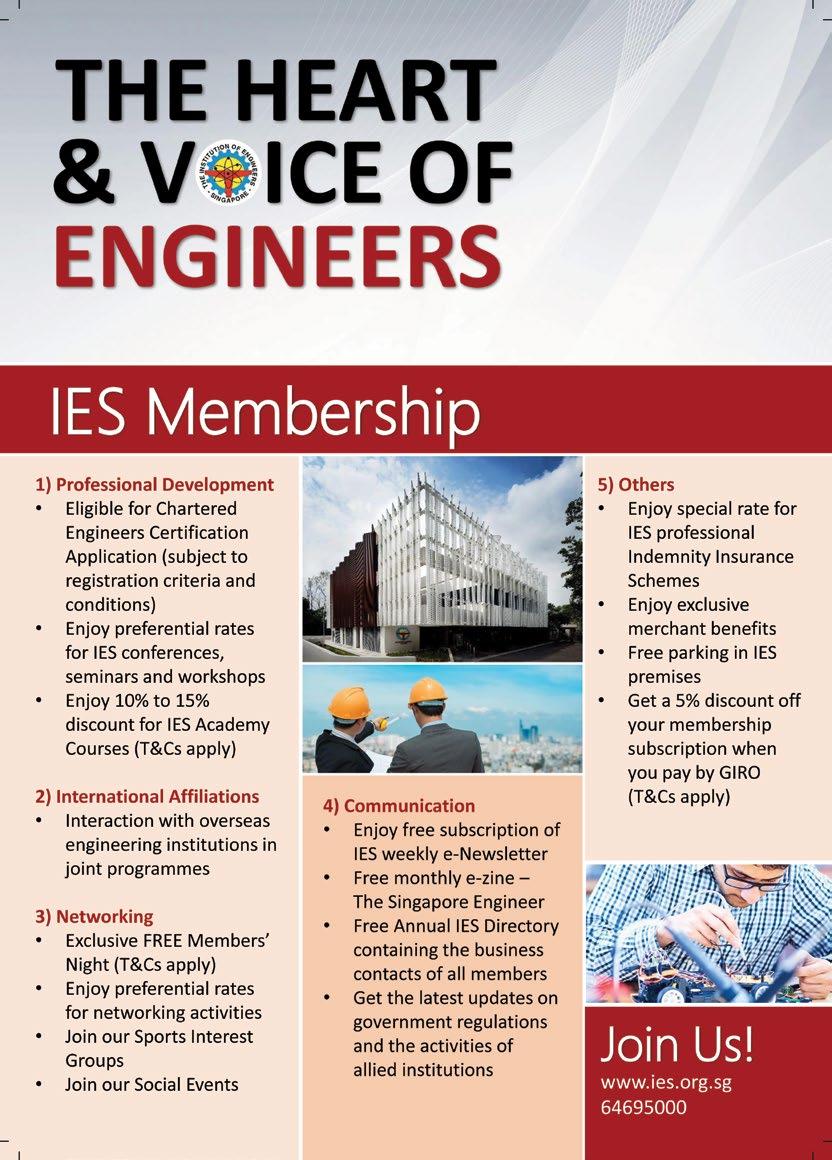
13 Singapore scientists develop revolutionary microelectronic device
The breakthrough paves the way to more sustainable and efficient computing technologies in the future.
16 Surbana Jurong opens new global headquarters
The ‘Campus in Nature’ embodies commitment to creating a smart, sustainable future.
19 The importance of energy conservation
Analysis of energy consumption can help to reduce the carbon footprint.
22 Shifting attack landscapes and sectors in Q1 2024
Data on the growth of cyber threats is analysed.
25 Importance of digital security in protecting critical infrastructure
Ways to address the challenges are explained.
26 Simulation of shot blasting machines and processes
The benefits include lower costs and improved sustainability.
President Mr Dalson Chung
Chief Editor
T Bhaskaran
t_b_n8@yahoo.com
Publications Manager Desmond Teo desmond@iesnet.org.sg
Publications Executive Nuraini Ahmad nuraini@iesnet.org.sg
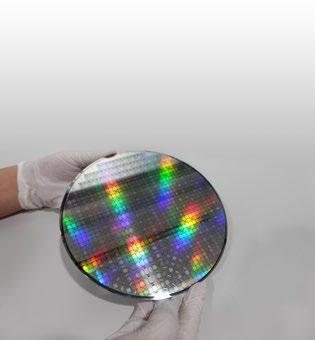
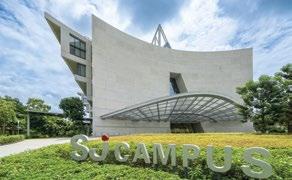
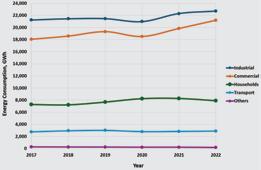
Editorial Panel
Dr Chandra Segaran
Dr Ang Keng Been
Dr Aaron Sham
A/Prof Yuzhu Pearl Li
Mr Jaime Vega Bautista Jr
Dr Victor Sim
Mr Soon Ren Jun
Dr Alexander Wiegand
Media Representative
Trevor Teh
IES@mnc-link.com
Design & layout by 2EZ Asia Pte Ltd
Cover designed by Irin Kuah
Cover image by A*STAR and NUS
Published by
The Institution of Engineers, Singapore
70 Bukit Tinggi Road, Singapore 289758
Tel: 6469 5000 I Fax: 6467 1108
Printed in Singapore
28 Applying a power cut machining strategy Shortcomings relating to tool life, productivity and process security, can be overcome.
30 Staying safe while travelling at 300 km per hour
Stringent safety protocols and advanced technology ensure the well-being of passengers.
32 Singapore Sustainable Air Hub Blueprint launched Twelve initiatives and five enablers to decarbonise Singapore’s aviation sector.
34 Strongest trade attendance in Singapore Airshow’s history This signals a renewed optimism and recovery in aviation.
35 Airbus to launch Sustainable Aviation Hub in Singapore The objective is to build a robust and environment-friendly aviation ecosystem.
36 Hydrogen to be a potential enabler to Singapore’s aviation decarbonisation
The necessary technologies, regulations, infrastructure and supply chains are being developed.
37 RTX’s Pratt & Whitney announces full operations of Singapore Technology Accelerator Over 30 innovations implemented to accelerate MRO performance.
38 SAESL expands into new facilities Advanced technologies will be deployed to meet rising MRO demand.
04 NEWS & EVENTS
40 PRODUCTS & SOLUTIONS


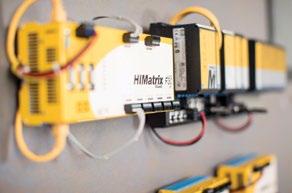
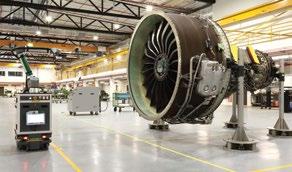
The Singapore Engineer is published monthly by The Institution of Engineers, Singapore (IES). The publication is distributed free-of-charge to IES members and affiliates. Views expressed in this publication do not necessarily reflect those of the Editor or IES. All rights reserved. No part of this magazine shall be reproduced, mechanically or electronically, without the prior consent of IES. Whilst every care is taken to ensure accuracy of the content at press time, IES will not be liable for any discrepancies. Unsolicited contributions are welcome but their inclusion in the magazine is at the discretion of the Editor.
Renowned Dutch microbiologist and expert in water quality and health, Professor Gertjan Medema, has been awarded the prestigious Lee Kuan Yew Water Prize 2024 for his breakthrough research and discovery, and significant contributions in the field of wastewater-based epidemiology (WBE).
His research revolutionised the application of WBE for virus detection in wastewater during the COVID-19 pandemic.
Professor Medema, Principal Microbiologist at the KWR Water Research Institute in the Netherlands, is the 10th recipient of the award which has been presented since 2008.
“It is my great honour and privilege to receive the distinguished Lee Kuan Yew Water Prize. This award is a recognition of the innovative use of wastewater as a data source for trends in COVID-19 circulation in our communities. I see it also as a recognition of the hard work of many people in the water sector globally, collecting COVID-19 data from wastewater to support our society’s response to the pandemic,” said Professor Medema.
“This tightens the connections between the water and health sectors. In the current post-pandemic world, wastewater monitoring is now firmly established as a tool for public health surveillance for an increasing number of diseases,” he added.
Contributions during the Covid-19 pandemic
With the emergence of COVID-19 in early 2020, Professor Medema and his team recognised the need for early detection and monitoring, and began collecting wastewater samples across the Netherlands to test for the SARS-CoV-2 virus.
He quickly focused his team’s research on curbing the spread of the virus in the community, through wastewater surveillance. The results were promising, when evidence of

the virus was detected in the wastewater of several cities, even before they were officially reported in these cities.
Professor Medema’s work has been foundational in establishing WBE as a tool for public health surveillance during the pandemic. The impact of his work was evident from his first publication in this area, which garnered substantial attention, with over 1,400 citations and more than 34,000 views between 2020 and 2023.
Wastewater surveillance has since been adopted, worldwide, as a powerful tool for the early detection of diseases like SARS-CoV-2, even before cases are reported through clinical testing. This, in turn, provides valuable insights into the prevalence of the virus in a community and is a proven cost-effective and non-invasive method for tracking the spread of the disease.
At the start of the COVID-19 pandemic in Singapore in 2020, National Environment Agency's (NEA) Environmental Health Institute (EHI) explored wastewater monitoring as an epidemiological tool and early warning system for outbreaks, in collaboration with PUB, Singapore’s
national water agency; the Home Team Science and Technology Agency (HTX); local universities, Nanyang Technological University and National University of Singapore; and research institute, Singapore Centre for Environmental Life Sciences Engineering (SCELSE).
Through partnerships with relevant institutions, Agency for Science, Technology and Research (A*STAR) and Public Sector Science and Technology Policy and Plans Office (S&TPPO), innovative solutions in wastewater surveillance were quickly developed to respond to the national need.
Singapore bolstered its national surveillance of COVID-19 transmission by expanding coverage to hundreds of sites, including water reclamation plants, workers’ dormitories, residential areas, town centres, student hostels and welfare homes.
Today, the wastewater sampling network covers more than 500 sites across Singapore. Apart from situational monitoring of COVID-19, wastewater surveillance has also been applied to monitor Zika transmission in Singapore. NEA and the network of partners will continue to conduct research and development to build on the wastewater testing system, to support public health in Singapore.
Significant impact on the global scientific community
Wastewater has been tested for SARS-CoV-2 in at least 72 countries at over 4000 reported sites (https:// www.covid19wbec.org/covidpoops19), with Professor Medema directly connected to about 30% of these programmes. Amidst his active involvement in international collaborations, and sharing of expertise and findings with the global scientific community, he has made great contributions to the development of international guidelines and best practices for wastewater surveillance.
Dedicated to advancing the science of waterborne pathogens, Professor Medema advises the World
Health Organization (WHO) on microbiological drinking water guidelines and Quantitative Microbial Risk Assessment (QMRA); SARS; Water, Sanitation & Hygiene (WASH); and wastewater surveillance.
He also advises the European Commission on the EU Drinking Water Directives and water reuse guidelines, thereby ensuring that the knowledge gained from his research is disseminated widely and applied effectively. His leadership in this area has helped to establish a network of researchers and practitioners dedicated to using WBE as a tool for public health surveillance.
Through Professor Medema, wastewater surveillance has been estab-
lished as a vital tool in safeguarding public health, as the world braces itself for other emerging diseases.
Professor Medema will receive the Prize, comprising an award certificate, a gold medallion and a cash prize of SGD 300,000 sponsored by the Temasek Foundation, from Mr Tharman Shanmugaratnam, President of the Republic of Singapore, at an award ceremony on Tuesday, 18 June 2024.
He will deliver a keynote lecture on Wednesday, 19 June 2024, during the Singapore International Water Week 2024 which is expected to be attended by 500 global water leaders, 2,000 delegates and more than 30,000 trade visitors.
PUB announces winners of three water-efficiency awards
PUB, Singapore’s National Water Agency, recently announced the winners of the prestigious Singapore Watermark Awards (SWMA), Water Efficiency Awards (WEA) and inaugural Water Efficiency Awards (Projects), recognising outstanding efforts in water efficiency and conservation in the non-domestic sector.
A total of 46 winners, ranging from manufacturing plants and data centres to commercial buildings and schools, received the awards.
Mr Ong Tze-Ch’in, Chief Executive of PUB, said, “Water is a critical resource to support Singapore’s economic growth. The award recipients have demonstrated an outstanding commitment to water efficiency and exemplify the spirit of innovation and stewardship in safeguarding Singapore’s precious water resource. I hope that their actions will inspire others to join the movement towards a more sustainable and resilient water future.”
Singapore Watermark Awards
The Singapore Watermark Awards (SWMA) is Singapore’s highest tribute for exceptional
achievements in water efficiency, conservation and advocacy.
The three SWMA winners are Amazon Web Services Singapore (AWS Singapore), Mee Toh School, and Systems on Silicon Manufacturing Company Pte Ltd (SSMC).
One of AWS Singapore’s new data centres has achieved top 10% water efficiency performance in the data centre sector. In this highly water-efficient data centre, AWS innovated with a local startup to deploy a homegrown wastewater recycling technology to further improve water efficiency, by allowing wastewater to be reused.
AWS Singapore also implemented employee education initiatives to raise awareness on water conservation, and supported the Science Centre’s Youth Science, Technology, Engineering and Mathematics (STEM) Empowerment Programme on sustainability, where their staff volunteers mentored students in developing project prototypes, including one that can reuse rainwater to generate energy.
Mee Toh School, a co-ed primary school located in Punggol, sig-
nificantly reduced its water usage by 30% between 2019 and 2022, through initiatives such as a rainwater collection system.
Furthermore, water sustainability is integrated as part of the school’s Environment Education curriculum.
SSMC has consistently achieved the highest recycling rate in its sector, since 2015, at an average of 67% as compared to the industry average of 45%. .
The Water Efficiency Awards (WEA) recognises the top 10th percentile of water efficiency performers in the respective sectors. This year, there are 35 WEA winners from 12 sectors.
The inaugural Water Efficiency Awards (Projects), or WEA (Projects), honours projects that have demonstrated excellent improvements in water efficiency, innovativeness and project leadership, and set the industry benchmark for best practices in water conservation. This year, there are eight WEA (Projects) recipients.
The Housing & Development Board (HDB) has awarded its eighth and largest solar leasing tender, to-date, under the SolarNova programme, to Sunseap Leasing Pte Ltd, an entity of EDP Renewables APAC.
This tender covers the installation of solar panels on about 1,075 HDB blocks and 101 government sites, creating a solar capacity of 130 megawatt-peak (MWp). This is about 15% higher than the earlier estimates of 113 MWp.
Separately, HDB has also awarded tenders to Chevalier Singapore Pte Ltd and EM Services Pte Ltd, to retrofit 4,000 lifts, island-wide, with the Elevator Energy Regeneration System (EERS).
Both the SolarNova programme and EERS, rolled out under the HDB Green Towns Programme, are part of HDB’s efforts to reduce energy consumption in HDB towns.
The HDB Green Towns Programme is a 10-year plan to bring sustainable living to all existing HDB towns, with large-scale implementation of green features to improve residents’ quality of life. It is a key initiative under the Singapore Green Plan which aims to build a more sustainable future for Singapore in the face of climate change.
HDB’s Chief Sustainability Officer and Group Director of Building & Research Institute, Mr Tan Sze Tiong, said, “The Green Towns Programme helps to mitigate climate change while creating a cleaner and more comfortable living environment for our residents, such as through initiatives that reduce energy consumption in our towns.”
“Other green initiatives introduced under the programme aim to recycle rainwater, cool our towns, encourage green commute and reduce waste. We will continue to explore new initiatives to improve residents’ quality of life, stretch HDB’s sustainability targets, and support the national goal of achieving a

green and sustainable Singapore,” he added.
SolarNova 8, the latest SolarNova tender, will include the use of a novel advanced technology to prolong the lifespan of solar panels, marking the first time that the technology is being used, since the launch of the SolarNova programme in 2014.
Generally, solar panels can last about 25 to 30 years. They undergo natural degradation due to ageing and changing weather conditions. Due to degradation, a solar panel would, on average, generate around 12% to 15% less power, towards the end of its lifespan.
To prolong the lifespan of a solar panel, EDP Renewables APAC has collaborated with EtaVolt to pilot an advanced regeneration technology for solar panels on HDB blocks, which can extend the lifespan of each solar panel by 4 to 5 years.
This patented technology developed by EtaVolt relies on intense light to re-energise the solar cells and repair them at the molecular level, and recover up to 5% of the solar panel’s efficiency, depending on panel structures, in minutes. This advanced regeneration activity only needs to be carried out, at most, once a year.
EtaVolt is a technological spin-off
from the Nanyang Technological University of Singapore, that focuses on sustainable solar renewable energy businesses in Singapore as well as in neighbouring countries in Asia.
Progressive installation of solar panels
HDB’s solar journey began in 2008 and, today, it is the largest driver for the installation of solar photovoltaic (PV) systems in Singapore. Including the eight SolarNova tenders and efforts prior to the SolarNova programme, HDB has committed a total solar capacity of 455 MWp across HDB estates, which is equivalent to powering approximately 114,000 4-room flats. This is almost 85% of HDB’s solar target of 540 MWp by 2030.
In HDB estates, solar energy that is harnessed is first used to power common services, such as lifts, lights and water pumps, in the day. Excess solar energy is then channelled to the grid. On average, HDB is able to achieve net-zero energy consumption for the common areas of HDB blocks where solar panels have been installed.
Installation of solar panels under SolarNova 8 is expected to commence in 2Q2024 and be completed by 3Q2026. HDB aims to install solar panels on as many blocks as possible. To-date, solar panels
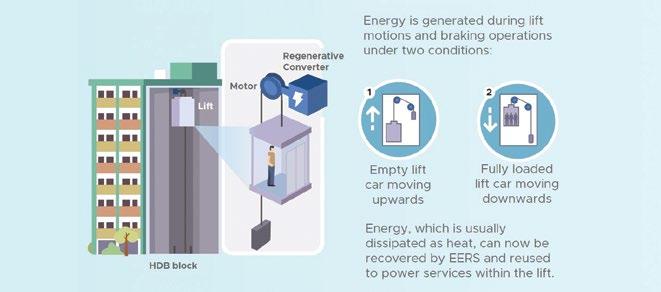
have been installed on about 3,900 HDB blocks. For the remaining HDB blocks, where feasible, solar panels will be progressively installed, in batches, over the next three years. Actual installation will be determined, based on the site conditions for each block.
HDB has also awarded tenders to Chevalier Singapore Pte Ltd and EM Services Pte Ltd for the retrofitting of 4,000 lifts island-wide with the El-
evator Energy Regeneration System (EERS). Retrofitting works will commence in 2Q2024 and be completed by 2030.
The EERS recovers energy generated during lift motions and braking operations, to power other services such as lighting, ventilation and the lift display panel within the lift. With the EERS, lift energy consumption can be reduced by an average of 20%.
As the master developer of public
REC Group, an international pioneering solar energy company, has received the ‘Best Solar Panels’ and ‘Best After-Sales Support’ awards, in 2024, for the second consecutive year. These awards come from SolarQuotes, with insights gathered from installers across Australia.
Since its foundation in 2009, SolarQuotes has published almost 80,000 solar PV reviews, built a network of more than 600 trusted solar installers and helped almost 760,000 people to get high quality solar quotes. For ‘Best Solar Panels 2024’,
REC retains the Gold. with 45% of the vote.
The REC Alpha Pure product family, in particular, stood out for its efficiency and durability, making it a top choice among installers and homeowners alike.
In the ‘Best After-Sales Support’ category, REC has been recognised for its dedication to providing support. In an era where long-term reliability is paramount, this award highlights REC’s commitment to backing its products with customer service.
“We are thrilled to receive
housing in Singapore, HDB plays a key role in supporting the nation’s commitment to sustainable development. The award of the SolarNova 8 and EERS tenders marks another step forward in reducing energy consumption in HDB towns, and building a more sustainable and greener environment for residents. HDB will continue to explore new green initiatives that can be added under the Green Towns Programme, to intensify the sustainability efforts.
these prestigious awards for the second year in a row. This recognition from Australian solar installers is a testament to the hard work and dedication of our valued research, technical expertise and after-sales support teams at REC,” said Gus Paviani, Head of APAC and Japan at REC Group.
REC is headquartered in Norway with operational headquarters in Singapore and regional hubs in North America, Europe, and Asia-Pacific. In December 2021, REC became part of Reliance Industries Limited, India.
Underlining a landmark collaboration that underscores a shared commitment to sustainability and innovation, Meinhardt Singapore Pte Ltd, a global leader in engineering, infrastructure and project management consulting, has signed a Memorandum of Understanding (MoU) with Ngee Ann Polytechnic (NP).
This partnership aims to spearhead advancements in smart and sustainable facilities management, reflecting both organisations’ dedication to nurturing future-ready talents, and creating resilient and sustainable urban solutions.
The MoU marks a significant stride towards integrating real-world engineering challenges and digital solutions into the academic curriculum and research, and promises to unlock new opportunities for students, faculty and industry.
Under the framework of the MoU, both parties will engage in discussions in relation to sustainable and resilient buildings, carbon footprint reduction, infrastructure and environment, climate change and asset management with resilient systems, digital twins and other built environment technologies.
“At Meinhardt Group, we envision a world where infrastructure and urban developments not only embody innovation but also tread lightly on our planet. This partnership with Ngee Ann Polytechnic represents a pivotal step in that direction, offering a unique confluence of academic rigour and industry expertise to empower the next generation of green leaders in the built environment sector. By aligning our efforts, we are setting new benchmarks for what is achievable in the realm of smart and sustainable facilities management,” said Mr Omar Shahzad, Group CEO of Meinhardt Group.
The collaboration will unfold across various initiatives including joint research and consultancy projects; the co-creation, development and showcasing of systems,

platforms and solutions at NP; the formation of tripartite partnerships with other educational and research institutions; and the development of specialised training, attachment and internship programmes for NP students and faculty alike.
These programmes span the gamut, from online and face-to-face seminars, webinars and workshops to specialist training courses, career transition programmes, short courses and part-time diplomas.
Dr Eugene Seah, Chief Operating Officer of Meinhardt Singapore Pte Ltd, highlighted the importance of this collaboration in driving forward the group’s mission to deliver sustainable and buildable solutions.
“This MoU represents Meinhardt’s commitment to nurturing talents who are not just adept at navigating today’s challenges but can also envisage and engineer the sustainable solutions of tomorrow. Together with Ngee Ann Polytechnic, we are eager to co-create a future where innovation leads the way to environmental stewardship and societal well-being,” said Dr Seah.
“This endeavour aims not only to enrich the learning experience but also to equip participants with the practical skills and knowledge essential for addressing the environmental and technological challenges of the future, by expanding the boundaries of classrooms into the working world, making each space a living and learning lab,” he added.
In conjunction with the MoU, NP has unveiled the SEED (Sustainability Education & Ecosystem Development) initiative, aiming to cultivate sustainability-intelligent graduates poised to contribute to the green economy. By embedding sustainability across its curriculum and fostering industry partnerships, NP sets a precedent for educational institutions striving towards environmental excellence.
“We are invested in forging strategic alliances to innovate sustainable solutions. The synergy between Meinhardt Singapore and Ngee Ann Polytechnic through this MoU provides a robust platform for pioneering sustainable practices and technologies in the built environment sector. It reflects our shared aspiration to play an instrumental role in Singapore’s transition towards a greener future,” said Mr Lim Kok Kiang, Principal and CEO of Ngee Ann Polytechnic.
As part of the SEED initiative, NP will focus on developing sustainability-focused curricula, greening its campus, and forging strategic industry partnerships, including with Meinhardt Group, to drive innovation and talent development in sustainability. By leveraging Meinhardt’s extensive experience in delivering large-scale and complex projects worldwide, and NP’s innovative educational approaches, this partnership hopes to make significant contributions to the field of smart and sustainable facilities management.
Advanced Substrate Technologies Pte Ltd (AST), a Singapore-based subsidiary of TOPPAN Holdings Inc, a Japanese pioneer in printing technologies and a leading supplier of high quality Flip Chip Ball Grid Array (FC-BGA) substrates, recently broke ground in Singapore for the construction of its new factory.
An FC-BGA substrate enables the interconnection between one or more silicon dies and the system board and also between those silicon dies, through its multiple layers of high density wiring.
This factory will be the first in Singapore to manufacture high-end FC-BGA substrates used in bleeding edge semiconductor products such as Network Switches and Artificial Intelligence (AI) / Machine Learning (ML) devices. The production rampup is part of TOPPAN’s strategic growth plan to address the increasing global and regional demand for advanced substrates, and complements its main production hub in Japan.
Research and development (R&D) on advanced substrate technologies will also be conducted at AST’s new facility, to meet future performance demands of products for such applications.
With a target to start production by the end of 2026, AST’s factory will implement advanced factory automation to produce substrates of high quality and yield. The factory, with about 95,000 m2 floor area, will also employ over 200 high-tech engineers and skilled technicians, besides other operators, providing them with an opportunity to learn and lead in the field of FC-BGA substrate manufacturing and development.
TOPPAN will bring the company’s most advanced substrate manufacturing know-how for implementation in AST’s production lines. TOPPAN’s large-body and high-layer-count substrate technology is
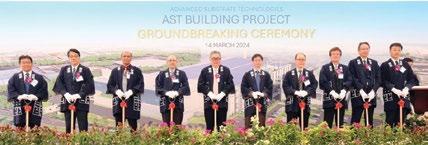
proven in the products of several well-known large semiconductor companies worldwide. AST’s initial and key hires for FC-BGA substrate manufacturing will undergo intensive training in TOPPAN’s Niigata factories in Japan.
Broadcom Inc, a global technology leader that designs, develops and supplies a broad range of semiconductor, enterprise software and security solutions, is also supporting the establishment of this world class manufacturing facility in Singapore.
“AST will be our first ever FC-BGA manufacturing facility outside of Japan. AST will provide high-end FC-BGA substrates that are essential for cutting-edge semiconductor products,” said Mr Tetsuro Ueki, Senior Managing Executive Officer and Head of TOPPAN’s Electronics Division.
“By leveraging the design and manufacturing expertise developed at TOPPAN Japan’s Niigata Plant and combining it with stateof-the-art automation technology, AST will achieve the highest quality and production efficiency. We sincerely appreciate the unwavering support from the Singapore government agencies, EDB and JTC, and the invaluable assistance from our esteemed client, Broadcom, which made this project possible,” Mr Ueki added.
Mr Pee Beng Kong, Executive Vice President of the Economic Development Board of Singapore, said, “AST’s new facility is a significant
addition to Singapore’s semiconductor ecosystem, which today already hosts a diverse range of manufacturers and suppliers. Singapore continues to strengthen our business-friendly environment, innovation ecosystem and connectivity to the world, to remain a critical global node for semiconductors”.
“We are therefore glad to be chosen to host TOPPAN’s first FC-BGA substrate manufacturing facility outside Japan. This is one of Japan’s largest investments, overseas in the past decade, for a key component in the semiconductor supply chain. EDB remains keen to partner with semiconductor companies globally across the value chain, and we look forward to achieving future milestones with partners like Broadcom and TOPPAN,” he added.
“As TOPPAN’s largest customer for FC-BGA substrates, we welcome the additional capacity AST brings for large body, high layer count substrates,” said Dr Charlie Kawwas, President of Broadcom’s Semiconductor Solutions Group.
“We are also delighted that this factory is getting established in Singapore, with a world class talent pool, a vibrant semiconductor ecosystem and outstanding support by the Singapore EDB and government agencies. Advanced technologies developed at AST will be strategically important to us for differentiating our next generation Networking and AI/ML products and sustaining our market leadership,” he added.
The Association for Materials Protection and Performance (AMPP) was launched in January 2021, following the merger between Houston-based NACE International – The Corrosion Society, formerly the National Association of Corrosion Engineers (NACE) and Pittsburgh-based SSPC: The Society for Protective Coatings, after more than 145 combined years of acquiring corrosion control and protective coatings expertise, and serving members worldwide. AMPP is dedicated to the protection
The
of materials, through the advancement of corrosion control and protective coatings. AMPP protects infrastructure and assets worldwide through member and workforce education and credentialling, company accreditation, innovation and global standardisation.
Today, AMPP has more than 33,000 members and is active in more than 130 countries. Headquartered in the US, AMPP has several offices within the US and in Canada, United Kingdom, China, Malaysia, Brazil and

Saudi Arabia.
Established in September 2023, the AMPP Singapore Chapter serves more than 300 members based in Singapore, whose mission is to protect infrastructures and assets from corrosion.
AMPP hosts seminars and workshops, and facilitates the exchange of ideas and solutions among its members, local authorities, private industries, academics and others.
More information on AMPP may be obtained from www.ampp.org.
The economies in the Asia Pacific (APAC) region are particularly vulnerable to nature-related risks, including biodiversity loss, pollution and fresh water availability, according to data released recently by the Asia Investor Group on Climate Change (AIGCC) and PwC.
53%, or USD 18 trillion, of APAC’s Gross Value Add (GVA) is in economic sectors that are moderately or highly directly dependent on nature.
This includes reliance on fertile soils, clean water, pollination and climate stability, all of which are in serious decline in many parts of the region.
• 20%, or USD 7 trillion, of APAC’s GVA is in sectors with higher direct exposure – including agriculture, construction, fishery and aquaculture, food systems and forestry.
• This is higher than the global figure of 16%.
• 33%, or USD 11 trillion, is in sectors with moderate direct exposure, including energy, manufacturing and services.
• The remaining 47% is in sectors including Real Estate, Healthcare,
IT and Retail, where the nature risk exposure is more likely to be indirect.
Public equities are even more exposed, with 58% of regional market capitalisation being moderately or highly directly dependent on nature.
• 11 out of the 14 APAC stock exchanges have more than 50% of market capitalisation, with higher or moderate direct dependency on nature.
• The Taiwan Stock Exchange (TWSE) (44%), New Zealand Stock Exchange (NZSE) (42%), and Shanghai Stock Exchange (SHSE) (37%) stock exchanges had the highest proportion of market capitalization, with higher direct nature dependence.
AIGCC and PwC have developed a checklist as general guidance for investors to identify and manage nature-related risks.
• Understand expectations and identify relevant information required to assess nature-related risks in their portfolio.
• Gain top management and board commitment on nature.
• Confirm priorities for action through the assessment of assets and portfolio exposure, taking into account sectors and geographical locations, to develop investors’ approach or policy on nature.
• Identify relevant industry and market-related initiatives that can be leveraged.
• Regularly engage with priority sectors and the key companies that are represented in specific supply chains within investment portfolios.
• Adopt the most relevant framework for nature-related reporting and target setting for investments. AIGCC recommends The Taskforce on Nature-related Financial Disclosures (TNFD) recommendations and the Science-based Targets Network’s (SBTN) science-based targets for nature.
The forthcoming report ‘Nature at a Tipping Point’ by AIGCC and PwC, substantiated by case studies from corporates and investors, demonstrates how to effectively manage nature-related risks.
From 22 to 25 October 2024, EuroBLECH, the 27th International Sheet Metal Working Technology Exhibition, will be held at the Hanover Exhibition Grounds in Germany. It is the world’s largest exhibition for sheet metal processing, covering the entire supply chain in 15 different technology sectors.
Visitors can look forward to a number of live demonstrations and world premieres which provide the opportunity to explore, assess and discuss the benefits and gains of specific technology solutions for their own production processes.
Organised by RX, EuroBLECH 2024 will occupy nine halls at Hanover Exhibition Grounds, the world’s largest exhibition centre. The uptake on stand space has been strong, in particular, from international exhibitors, with more than 60% of exhibitors joining from outside Germany.
Over 90% of available stand space has already been booked. As such, the show mirrors the global significance of the sheet metal sector in the wider economy. Besides Germany, the major exhibitor countries are Italy, Turkey, China, Spain, the Netherlands, Switzerland, Taiwan, Belgium, Austria, France and the US.
Live on the show floor
EuroBLECH provides numerous opportunities to watch innovative machinery live in action. For many of the regular visitors, EuroBLECH offers access to a broad spectrum of tech suppliers, with exhibits on the processing of metal sheet, tubes, profiles, plastic hybrids and other related applications.
Exhibits on display will include stamping presses, CNC punching machines, press brakes and other machines and tools for cutting, punching and forming, joining, welding and fastening, surface treatment and finishing; solutions for process control and quality assurance; machine elements and components; CAD/CAM/CIM systems; warehouse
and factory equipment; material recycling equipment; and more.
For the first time, visitors will be able to book curated visitor tours. Also reflected in this year’s motto for EuroBLECH, ‘The Power of Productivity’, the organised visitor experiences will focus on productivity-enhancing technology. The tours will include 10-minute presentations at each stop, followed by a short Q&A session. There are two different tour options to choose from:
Tour 1: ‘Industrial Internet of Things (IIoT)’ will cover key topics such as big data, remote analysis, predictive maintenance, production monitoring, and part traceability. Participants will discover various products, tools and software to help them plan, optimise and monitor production, with a view to improving their overall productivity, efficiency and sustainability.
Tour 2: ‘Automation and Robotics for Efficient Production’ will demonstrate how integrated, bolton or stand-alone automation and robotics systems can streamline production operations for greater sustainability and productivity, even for small batches. These can range
from handling, sorting, conveying, storage and stacking systems to robots, cobots and autonomous mobile robots (AMRs).
In addition to the innovations and numerous live demonstrations on the exhibition stands, attendees can benefit from the EuroBLECH 2024 Speaker Forum at two dedicated presentation theatres for expert talks and panel discussions.
Sessions will run on all four show days and offer insights into the latest projects and product developments, as well as valuable networking opportunities and meaningful exchanges amongst peers.
The EuroBLECH Industry Awards are making a comeback at EuroBLECH 2024. Recognition will be given for the most innovative products, solutions and digitalisation concepts, in various categories. The winners will be selected by industry professionals via online voting, starting in autumn 2024, and the awards will be presented at the exhibition.
More information on EuroBLECH 2024 may be obtained from www.euroblech.com.

The demands and challenges associated with industrial parts production have changed significantly in recent years.
The PARTS FINISHING trade fair, which will be held for the first time, at the Karlsruhe Exhibition Centre, Karlsruhe, Germany, on 13 and 14 November 2024, addresses the changing needs of the manufacturing industries. The new format features a comprehensive focus on the production steps of deburring, component cleaning and surface finishing – from standalone processes right up to networked production lines.
In order to be competitive in growth markets, companies are required to be more flexible and agile, and to focus more sharply on process sequences and value chains. At the same time, industrial production has to fulfil ever-increasing demands in terms of component quality, costeffectiveness and sustainability.
“This leads to a steadily growing need for information and knowledge in manufacturing companies. Technical trade fairs play an important role in this regard. However, the focus of the respective exhibitions has thus far been limited to a great extent to individual production steps, which means that several trade fair visits are required to obtain comprehensive information, which is becoming increasingly difficult in times of personnel shortages and cost efficiency,” said Mr Hartmut Herdin, Managing Director of private trade fair promoters fairXperts GmbH & Co KG, initiator and organiser of PARTS FINISHING.
“PARTS FINISHING has been specifically developed to provide suppliers and users of solutions for deburring, component cleaning and surface finishing with an ideal platform,” he added.
Suppliers from the quality-relevant fields of deburring technologies, industrial cleaning technology and surface finishing will present their spectrum of solutions at the
new event. Beyond this, attention will be focused on trends and innovations for automation, the digital transformation, process networking and improving resource efficiency in these production steps.
The trade fair together with integrated expert forum is a platform for companies, experts and research institutions who want to showcase innovative solutions and technologies, exchange knowledge and experience, and discuss industrial trends.
Benefits for exhibitors and visitors Exhibitors can significantly reduce costs and the allocation of resources thanks to the compact two-day event. Premium exhibition booth concepts and fixed costs minimise preparation expenses and increase the profitability of trade fair participation. The event concept also promotes the establishment of strategic partnerships and the development of joint projects amongst exhibitors.
Visitors to PARTS FINISHING will

benefit from a comprehensive overview of the state-of-the-art, current developments and trends, as well as practice-oriented presentations held at the expert forum. This makes it possible for visitors to find targeted solutions for individual challenges, in order to optimise processes or adapt their range of products and services to changing requirements.
PARTS FINISHING is thus leaner, shorter and more cost-effective than conventional trade fairs.
More information on PARTS FINISHING can be obtained from info@ fairxperts.de.
As one of the leading global water events focused on innovation and solutions, the 10th Singapore International Water Week (SIWW), to be held from 18 to 22 June 2024 at the Sands Expo and Convention Centre in Singapore, will once again play host to over 2,000 global leaders, experts and practitioners from governments, cities, water utilities, agencies, industry and academia to share and co-create innovative solutions to solve the world’s urban water and associated climate challenges.
SIWW2024 is organised by PUB, Singapore’s National Water Agency, and Singapore’s Ministry of Sustainability and
the Environment. Key themes such as climate mitigation, water sustainability, net zero and decarbonisation, resource circularity, digitalisation, and a new pillar on climate adaptation, will be featured across SIWW flagship programmes including the Lee Kuan Yew Water Prize Presentation, Leaders Roundtable and Summit, Water Convention, and Water Expo.
In anticipation of the event, a roadshow was held in Hanoi, Vietnam, recently, which was attended by more than 100 local senior utility and industry leaders, distributors, industrial water end-users, as well as trade associations and chambers.
The breakthrough paves the way to more sustainable and efficient computing technologies in the future.
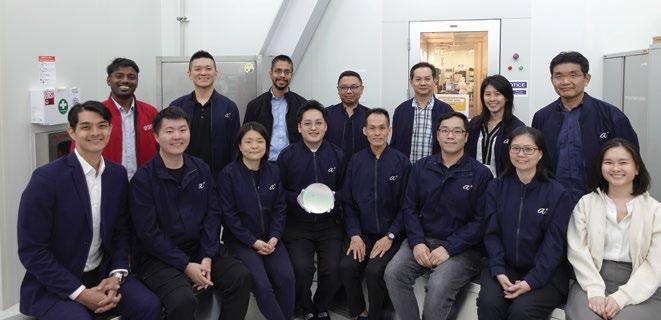
A research team, led by the Agency for Science, Technology and Research (A*STAR) in partnership with National University of Singapore (NUS), has created an innovative microelectronic device that can potentially function as a sustainable, high-performance ‘bitswitch’.
Bit switching, the process of changing a bit from 0 to 1 and vice versa, is a fundamental operation for computing. Computers encode information in sequences of bits. Each bit represents either 0 or 1.
This breakthrough, by the research team, paves the way for future computing technologies to process data much faster while using significantly less energy.
By harnessing tiny, stable and speedy magnetic whirls called skyrmions, the device can operate using 1,000 times less power than commercial memory technologies.
This discovery was reported in the scientific journal, Nature, on 21 March 2024.
The need for more sustainable and efficient AI computing
Emerging AI technologies such as ChatGPT require large amounts of data to be processed at blazing speeds, which draw on immense computing power. Infocomm technologies already consume nearly 20% of global electricity [reference: ‘Impact of Information Technology on Global Energy Consumption’ (goglobe.com)].
The consumption is set to spike even further, with the growth of such large AI models. To meet these rapidly growing demands, the fundamental computing ‘switch’, or memory-bit, has been scaled down to ever-smaller sizes, and is approaching its physical limits.
A binary digit or bit is the basic
unit of data in digital computing and digital logic, representing a state that can be either 0 or 1. Much like a light switch, it can have two positions – on or off. In the context of computing, these two states translate to 0 (off) and 1 (on).
A prominent approach to mitigate the energy crisis, especially for mobility, healthcare and manufacturing domains, is edge computing. Here, data is processed within individual appliances, such as phones, smart home appliances and vehicles, rather than in power-intensive, largescale data centres.
However, edge appliances are presently unable to perform complex computational tasks due to limited computing capacity and power constraints. There is a pressing need to develop a radically different microelectronic platform, in order to achieve efficient and sustainable AI computing.
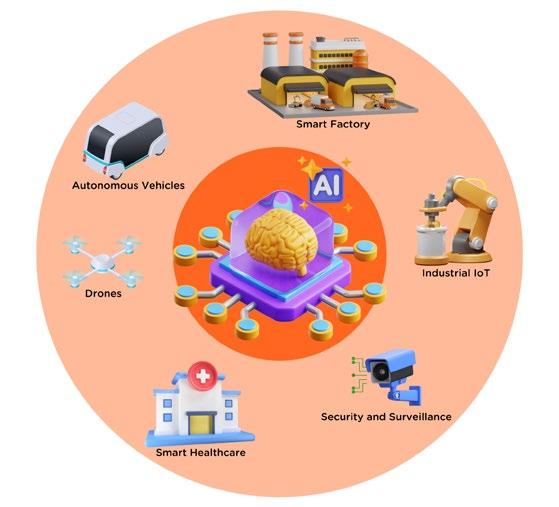
AI appliances and applications. Image: A*STAR.
Skyrmions for the future of computing
Skyrmions are tiny magnetic whirls – 10,000 times smaller than the width of a human hair – that form within specific magnetic layers when they are made extremely thin. Discovered only a decade ago, these whirls can be extremely stable and compact, and can be efficiently moved between magnetic regions. They form ideal mobile switches for efficient, large-scale data processing for AI technologies.
Activating the potential of skyrmions
To tap on the vast potential of skyrmions, it is critical to access them using electrical pathways such as those employed in computers. While skyrmions can be seen under special microscopes and have been manipulated using bulky magnets
for over a decade, the absence of electrical control has been a critical impediment to their technological relevance.
The team from A*STAR and NUS is the first to achieve electrical readout (identification) of a skyrmion and electrical switching between states (e.g. from ‘0’ to ‘1’ and vice versa). To do so, the scientists employed a device known as a tunnel junction which is operable under ambient conditions and is used extensively in commercial memory and hard disk applications. The team discovered that the special attributes of skyrmions enable the switching between states using 1,000 times less power than commercial devices. They also found that more than two states can be achieved within a single device, which circumvents the need
to scale down the device size for enhanced performance.
Future directions
“Skyrmions have unique and elusive attributes that can be exploited to implement various AI architectures with unprecedented efficiency and functionality. Our microelectronic device provides the long-awaited key to unlocking their vast potential. It will help cement skyrmions as an integral component for the future of computing,” said the team leader, Dr Anjan Soumyanarayanan, Principal Scientist at A*STAR’s Institute of Materials Research and Engineering (IMRE) and Assistant Professor at the NUS Faculty of Science’s Department of Physics.
“Our microelectronic devices are fabricated on 200 mm silicon wafers using materials and methods readily
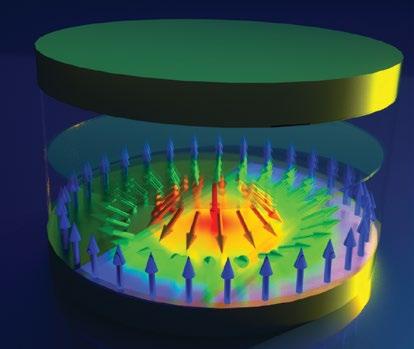
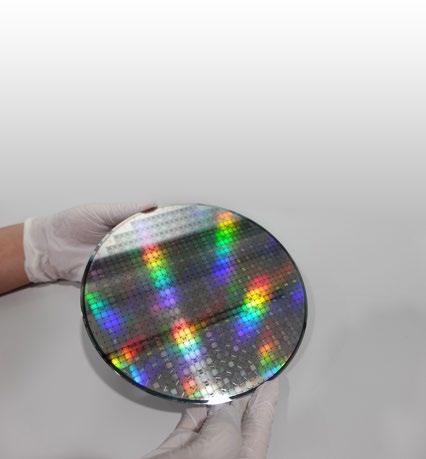
employed in existing microelectronic foundries in Singapore and globally. We hope to collaborate with the electronics cluster ecosystem to accelerate the practical integration of these devices with existing edge computing technologies,” said Dr James Lourembam, Senior Scientist at IMRE’s Electronic Materials Department.
The team hopes that with further refinement of the electrical performance, the enhanced computing switch can be readily inte-
grated into microprocessors using established approaches. The team is looking to collaborate with semiconductor manufacturing companies and system integrators to scale up the technology for wider adoption.
The Agency for Science, Technology and Research (A*STAR) is Singapore’s lead public sector R&D agency. Through open innovation,
A*STAR collaborates with partners in both the public and private sectors to benefit the economy and society. As a Science and Technology Organisation, A*STAR bridges the gap between academia and industry.
The organisation’s research creates economic growth and jobs for Singapore, and enhances lives by improving societal outcomes in healthcare, urban living and sustainability. A*STAR plays a key role in nurturing scientific talent and leaders for the wider research community and industry. The organisation’s R&D activities span biomedical sciences to physical sciences and engineering, with research entities primarily located in Biopolis and Fusionopolis.
National University of Singapore National University of Singapore (NUS) is Singapore’s flagship university and offers a global approach to education, research and entrepreneurship, with a focus on Asian perspectives and expertise.
NUS has 16 colleges, faculties and schools across three campuses in Singapore, with more than 40,000 students from 100 countries enriching the vibrant and diverse campus community. NUS has also established more than 20 NUS Overseas Colleges and entrepreneurial hubs around the world.
The multidisciplinary and real-world approach to education, research and entrepreneurship enables NUS to work closely with industry, governments and academia to address crucial and complex issues relevant to Asia and the world.
Researchers at NUS’ faculties, research centres of excellence, corporate labs and more than 30 university-level research institutes focus on themes that include energy; environmental and urban sustainability; treatment and prevention of diseases; active ageing; advanced materials; risk management and resilience of financial systems; Asian studies; and Smart Nation capabilities such as artificial intelligence, data science, operations research and cybersecurity.
The ‘Campus in Nature’ embodies commitment to creating a smart, sustainable future.

Surbana Jurong (SJ) recently announced the official opening of the SJ Campus in Singapore, the company’s new global headquarters, at a ceremony graced by Singapore Deputy Prime Minister and Minister for Finance, Mr Lawrence Wong.
Set within CleanTech Park in Jurong Innovation District (JID) and with a built-up area of 1,200,000 ft2, the campus is a strategic centre for collaboration and learning, and a living lab for innovative solutions for the built environment.
JID is a vibrant ecosystem of enterprises pursuing smart city and urban solutions.
Designed by Safdie Architects working with SJ’s architects, the SJ Campus re-envisions the relationship between nature and the workplace. Aligning with the character of Singapore as a ‘City in Nature’, the SJ Campus is a ‘Campus in Nature’ that can accommodate 4,000 onsite employees and the wider community.
For the first time since SJ’s formation in 2015, as a collective of built environment consultants, employees in Singapore, from different entities within the firm, can finally congregate under one roof. The campus has been designed with both the SJ community and the community-at-large, in mind, creat-

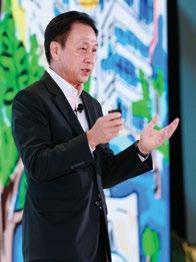
ing uplifting spaces that maximise engagement, facilitated by the site’s natural setting.
Mr Sean Chiao, Group CEO, Surbana Jurong, shared, “This campus is more than a global headquarters. It is a living lab for innovating solutions and pushing the boundaries of sustainable development. Over the years, SJ has assembled a portfolio to inject new thinking and talent into the group, and fuel our capabilities to transform the built environ-
ment. In SJ Campus, our diverse talents come together to collaborate and solve our clients’ most complex problems, fulfilling our purpose –Real impact, made together.”
SJ’s multidisciplinary team undertook much of the work that brought the campus to life, providing consultancy services, from architecture, landscape architecture, engineering and project management, to workplace strategy, integrated facilities management, and security services.
Mr Chaly Mah, Chairman, Surbana Jurong, said, “Today marks a signifi-

cant milestone in SJ’s evolution. We have a strong platform to continue our aspiration of becoming a leading global architecture, engineering, design consultancy. As we open our doors to the wider community, we invite all to join us in shaping a smart, resilient and regenerative future. Working together with our clients, partners, our people and the community, we are committed to creating a future legacy that is greater than our collective past, one that serves generations to come.”
Situated on a previously undeveloped greenfield site, the SJ Campus design preserves more than half of the site’s existing green space and replaces built-upon green areas with rooftop gardens, lush interior gardens, and extensive exterior landscaping. At the outset, a detailed mapping and analysis of the site was performed to plot the specific location of the existing flora, including a Banyan tree estimated to be over 60 years old.
The 10 towers of the campus are linked by a pedestrian spine and enclosed courtyards, that allow for natural light and fresh air. Amenities further enhance the experience, including a 1,000-seater multipurpose area, a junior ballroom, rooftop terraces, a team lounge, table tennis and a soon-to-be opened gym. Many of these spaces take advantage of natural views, with large windows looking onto gardens.
The campus is a destination for walking trail enthusiasts, birdwatchers, cyclists and families exploring the Jurong Eco-Garden, home to a freshwater swamp, streams and Singapore’s last two dragon kilns. Cyclists are welcome to secure their bicycles at the onsite racks and utilise the campus shower facilities. To complete an outing, visitors can enjoy a meal at the cafeteria nestled within the campus grounds.
The project was awarded the BCA Green Mark Platinum Super Low Energy (SLE) and BCA-HPB Green
Mark Platinum for Healthier Workplaces certifications, by Singapore’s Building and Construction Authority (BCA).
The campus is designed for maintainability and deploys integrated facilities management to optimise operational efficiency. It is also WELL Pre-Certified by the International WELL Building Institute for having demonstrated a commitment to incorporate health and well-being features and practices.
The campus is distinguished by several features including the following:
• Engineering for sustainability: Through Design for Manufacturing and Assembly (DfMA), SJ constructed precast post-tensioned concrete frames in a unique arrangement, resembling inverted pyramidal cantilevered blocks. These structures form self-shading terraces, reducing solar radiation by a significant 36%. SJ’s design and engineering teams rigorously pursued a perfor-
mance-based approach, aligning with key sustainability objectives of the project.
• Best-in-class energy efficiency: The campus has adopted one of the largest underfloor air distribution systems in Singapore. This provides efficient cooling from below, to target occupied space and improve indoor air quality and generate additional energy savings of up to 16% of the cooling energy required.
Other smart facilities management solutions include an Integrated Command Centre, where IOT devices leverage artificial intelligence and machine learning to monitor energy, water, occupancy patterns and indoor air quality, to optimise carbon management and improve productivity.
These active systems and natural design elements work in combination to achieve an overall energy savings of 41%. SJ Campus is estimated to generate 4.4 million kWh/ year operational energy savings which is equal to avoiding 1,785 tons of carbon dioxide per year, based on Energy Market Authority’s grid emission factor.
• Renewable energy: SJ Campus has successfully integrated a next-generation solar photovoltaic (PV) system using bifacial PV panels which can produce clean energy when sunlight falls on either of its surfaces. The solar rooftops in SJ Campus serve as a testbed for advanced PV technologies, energy storage and the deployment of a smart grid.
Located in four towers, the solar PV system has a combined energy yield of 389 MWh per year, which is equivalent to powering 120 threeroom HDB flats every year. On-site renewable energy helps to offset Scope 2 emissions, saves energy costs, and earns renewable energy certificates (RECs).
• Role as a living lab: The campus serves as an incubator for real-world urban solutions to demonstrate the scalability of emerging technologies in the built environment industry. SJ is working with BCA to test-bed low carbon technologies to save energy and improve occupant health.
Financing the project
SJ adopted a ‘develop and lease’ model to fund the development of SJ Campus. SJ secured 100% funding for the development of the property and subsequent lease agreement for the entire land lease tenure, from M&G Real Estate, one of the world’s leading financial solutions providers for real estate investors. This arrangement has provided SJ with a compelling long-term and cost-effective solution in developing the property.
Surbana Jurong
Surbana Jurong (SJ) is a diverse collective of problem solvers for the built environment, continually reimagining ways to create a smart and sustainable future.
Headquartered in Singapore, the group has a global talent pool of 16,000 in its member companies, AETOS, Atelier Ten, B+H, CHIL, KTP, Prostruct, Robert Bird Group, SAA, SMEC and Surbana Jurong, based in more than 120 offices in over 40 countries. They include architects, designers, planners, engineers, facilities managers and other specialists, driven by progressive thinking and creative ideas.
Its technical experts deliver sustainable solutions that cover the entire project life cycle, from planning and design, through to delivery and management, as well as a full suite of multidisciplinary consultancy services across a diverse range of sectors including transportation, water, aviation, healthcare, hospitality and renewables.
A global urban, infrastructure and managed services consulting firm, with a track record of over 70 years in successful project delivery, SJ has built more than a million homes in Singapore, created master plans in more than 60 countries and developed over 100 industrial parks globally.
SJ is #23 in Engineering News-Record’s 2023 Top 225 International Design Firms; #14 in World Architecture 100 2024; and Asia Pacific FM Technology Provider of the Year 2022, awarded by International Facility Management Association.
SMEC awards funding for innovative green hydrogen methodology
SMEC is embracing green hydrogen as a part of the future energy mix by awarding Research and Development (R&D) funding to one of its specialist teams for the expansion of an innovative methodology for Green Hydrogen projects.
The novel methodology aims to capture and incorporate the complexity of the integration between renewable energy resources and the production of green hydrogen and its carriers, by using a holistic approach between components, and analysing the impact of the variability and complementarity of the renewable energy resources on the optimal system’s architecture.
Given the fast and evolving green hydrogen sector, clients and the market are looking for suitable methodologies and comprehensive energy models that capture the complexity of the different components of the system and provide reliable solutions.
This funding will assist the team in further developing novel scientific methodology to fill the engineering and scientific gaps, and include the variability and complementarity of different renewable energy sources needed to assist clients with their hydrogen projects holistically.
SMEC’s R&D Fund INNOVATE has been developed to foster continuous improvement and growth, through investment in innovation, research, software development and technology.
SMEC’s engineers will be collaborating with green hydrogen specialists from parent company, Surbana Jurong, bringing together global expertise to deliver the projects of the future.
Analysis of energy consumption can help to reduce the carbon footprint.
Introduction
Unprecedented technological advancements over the last few decades have resulted in an exponential growth in energy consumption around the globe, including in Singapore. Most energy consumed around the world is primarily from fossil fuels and their derivatives. In addition to the indirect emission of Green House Gases (GHGs), resulting from an imprudent use of electrical energy, direct emission also takes place through onsite burning of fossil fuels such as coal, diesel, and natural gas etc.
An ever-growing industrial sector, trying to catch up with the requirements of an expanding urban population, consumes the bulk of this energy, followed by the commercial and transportation sectors. So, it is of paramount importance to ensure that the mitigation strategies respond adequately to the ever-increasing energy consumption.
In this article, a brief account of the GHG phenomenon and the resulting climate change around the world will be discussed. In addition, a short discussion on the Significant Energy Use (SEU) systems in Singapore and the various energy efficiency improvement strategies legislated by the Singapore government is included.
The significance of rising Greenhouse Gas Emissions
The main human-generated GHGs are carbon dioxide (CO2), methane (CH4) and nitrous oxide (N2O). Emission of CO2 occurs from three main human activities – burning of fossil fuels, cement production as well as deforestation.
Figure 1 shows the quantity of CO2 produced, in grams, per gram of the common fuels burnt.
Figure 2 shows the percentage of GHGs (in CO2 equivalent) produced by different sources of emissions.
The overwhelming industrialisation around the globe along with deforestation increases the CO2 lev-

el in the earth’s atmosphere in an unprecedented manner, with a current reported level of 450 parts per million (ppm). The natural removal mechanisms of CO2 from the earth’s atmosphere are by dissolving of CO2

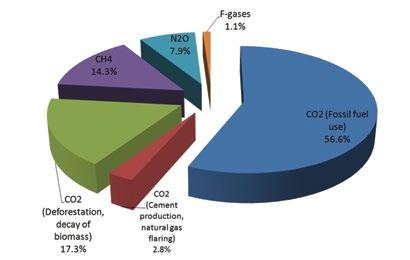
in the sea water as well as through the absorption by vegetation. In the pre-industrial era, this CO2 removal process was effective because of a low level of atmospheric CO2.
But in the modern industrialised world, there is a huge imbalance in the CO2 generated and the absorption capacity of the CO2, resulting in the formation of a CO2 blanket trapping the heat within the earth’s atmosphere. This produces global warming which is the principal cause of climate change.
Advanced computer climate models created by the scientists around the world predict a CO2 level of 450 ppm and a temperature rise of about 0.5 °C to 1.0 °C in the 2020s. The worst-case scenario predicted for the end of Year 2090 is a CO2 level of 958 ppm and a temperature rise of 4 °C, while an optimistic prediction, for a stabilised 540 ppm CO2 level and a temperature rise of 1 °C to 2 °C, has also been reported.
Severe droughts and floods are the adverse effects of global warming, with scientific studies suggesting that in 270 years, 20% of the world’s glaciers will melt, resulting in a significant rise in sea levels and flooding.
Based on the ‘Stern Review on the Economics of Climate Change’ (October 30, 2006), the worst impacts of global warming can be avoided if the CO2 equivalent level is stabilised at between 450 ppm and 550 ppm. This indeed would require emissions to be decreased by 25%, by 2050.
According to the report, without any action taken, CO2 levels could double by Year 2035. It also suggests that the resulting overall cost to the world would be at least 5% of the world’s economic productivity.
However, reduction of global warming would require an undertaking involving not more than around 1% of the world’s gross domestic product. This leads to the conclusion that the benefits of early action plans to mitigate the CO2 emission far outweigh the
economic and social costs of not acting.
Because of the adverse effects of GHG emissions, in particular, CO2 emissions, and their consequences such as climate change (causing severe floods and droughts), it is of paramount importance that the human community collectively resorts to a robust action plan to minimise the GHG emissions through prudent use of energy in all aspects of our lives.
We are living in an industrialised world with an unprecedented level of energy demand, especially by industrial companies, followed by commercial sectors such as data centres, office buildings, hospitality venues, shopping malls etc. Therefore, the solution to minimise GHG emissions lies in operating the SEUs in these sectors with the best possible energy efficiency.
Main energy consumers in Singapore
In Singapore, the main energy consuming sectors are the industrial and commercial sectors, with industry leading the list followed by the commercial sector. The industrial sector in Singapore comprises oil & gas, petrochemical, pharmaceutical, semi-conductor and food manufacturing companies.
Figure 3 shows the sector-wise energy consumption in Singapore, as of Year 2022, as published by Energy Market Authority (EMA), Singapore. As can be seen from Figure 3, the industrial sector leads in energy consumption, with about 41%, followed by the commercial sector, with a consumption of about 39% in Year 2022.
Figure 4 shows the energy consumption trend in Singapore, in various sectors, from Year 2017 to Year 2022, as also published by EMA, Singapore. Again, the industrial sector has led in energy consumption.
The energy consumption by Significant Energy Use (SEU) systems includes both fuel and electrical energy. For the heating requirements
of industrial companies, mostly natural gas fired steam generators / hot water boilers are in use, with diesel as a back-up fuel and with a fuel switching option available. Industrial companies emit CO2 both directly (through onsite burning of fuel) and indirectly (through using electricity from grid).
The main SEU systems in the industrial sector in Singapore are boiler systems, Compressed Dry Air (CDA) systems and chiller systems. SEU systems in Singapore’s commercial sector comprise mainly chiller systems and air distribution systems.
Energy efficiency improvements in the industrial sector, with a reduction of GHG emission as the goal, are spearheaded by the National Environment Agency (NEA), with legislations such as Energy Efficiency Opportunities Assessment (EEOA) and the Minimum Energy Efficiency Scheme (MEES) for chiller systems, subject to certain operational criteria.
The MEES is applicable to industrial companies with a total installed chiller cooling capacity of 300 RT and with the target of achieving a minimum chiller system efficiency of 0.67 kW/RT, again subject to certain operational criteria.
The MEES is expected to be completed for most companies by December 2025. More information is available at the NEA web portal (nea.gov.sg).
Both the above energy efficiency legislations are applicable to industrial companies, under the Energy Conservation Act (ECA) which has been in place since 2013. The operations of an industrial company consuming 54 TJ and above of energy will come under the purview of the ECA and the company will be required to have a mandatory Energy Efficiency Opportunities Assessment (EEOA) performed by a certified, independent, EEO Assessor.
A list of registered, independent EEO Assessors, with their areas of expertise, can be obtained from https://eeoa.sg/certified-eeoassessors/.
With several years’ experience in
the energy conservation sector in Singapore, my view about the opportunities for energy efficiency improvements in the industrial sector is optimistic. With a well-regulated energy efficiency sector under NEA, Singapore should be able to achieve the target of a 36% reduction in CO2 emissions over the reference year 2005, by Year 2030.
In this regard, SMEs consuming significant energy, but whose operations do not come under the ECA, could also volunteer and contribute to the cause, by having a detailed energy audit performed by an accredited Energy Services Company (ESCO).
A list of accredited ESCOs can be obtained from the NEA webpage.
The alarming rise in GHG emissions, in particular, CO2 emissions, around the world, is causing adverse effects such as climate change. The eradication of GHG emissions is impossible, however, their effects can be minimised through swift intervention and ensuring that the operation of SEU systems is at their highest efficiency levels.
The potential for energy savings in the industrial sector in Singapore can be identified thorough a detailed energy audit of the SEU systems, such as chiller systems, boiler systems and CDA systems. Even in the commercial sector, detailed energy audits can be performed on chiller systems and air distribution systems, to identify potential energy saving measures.

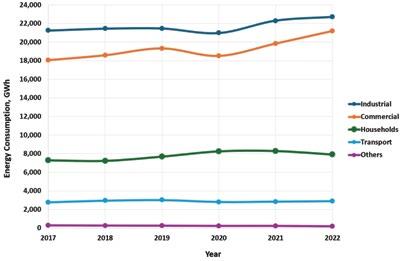

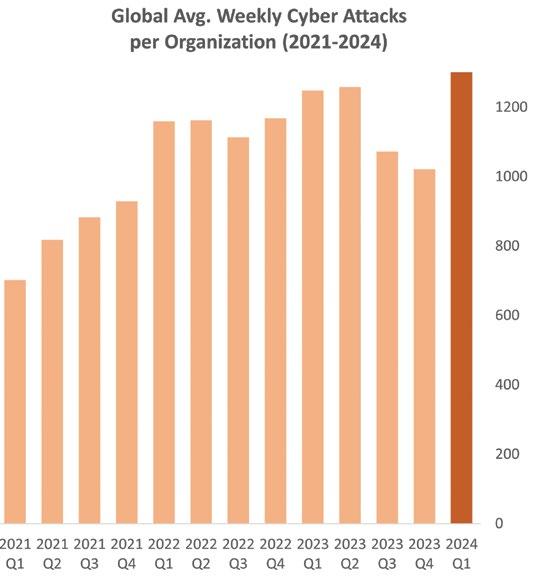
The realm of cybersecurity is an ever-evolving battlefield. As we stepped into 2024, the shadows of 2023’s massive cyber threats still loomed, setting a precedent for what was to come. The first quarter of 2024 has seen an intriguing shift in the landscape of cyber attacks,
both in the frequency and in the nature of threats.
Global cybersecurity trends for Q1 2024
In Q1 2024, Check Point Research (CPR) witnessed a notable increase in the average number of cyber at-
tacks per organisation, per week, reaching 1,308 – marking a 5% increase from Q1 2023 and a 28% increase from the last quarter of 2023.
This escalation is not just a number but a stark reminder of the persistent and evolving threat landscape, and
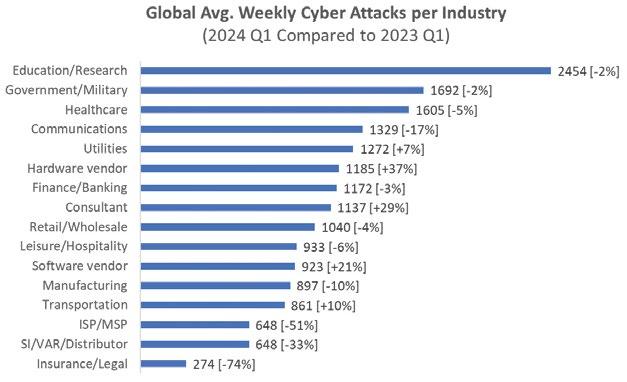
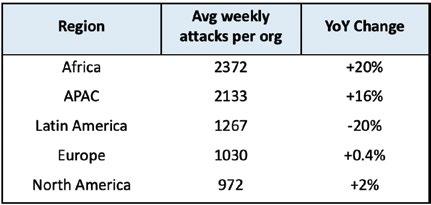
the substantial increase from Q4 2023 accentuates a worrying trend of rapid escalation in cyber threats.
Global attacks per industry
The Education/Research sector experienced a significant blow, with an average of 2,454 attacks per organisation, weekly, leading the chart in targeted industries, followed by the Government/Military (1,692 attacks per week) and Healthcare (1,605 attacks per week) sectors –
signalling an alarming vulnerability in sectors that are pivotal to societal function.
However, it is the substantial year-on-year increase in attacks on the Hardware Vendor industry, rising by 37%, that underlines a strategic shift in target preference for cybercriminals. This industry’s increasing reliance on hardware for IoT and smart devices makes these vendors lucrative targets for cybercriminals.
Regional analysis of overall attacks
Regionally, Africa surged to the forefront, with an average of 2,372 attacks per week, per organisation, a 20% jump from the same period in 2023. In contrast, Latin America showed a 20% decline, perhaps indicating a shift in focus or improved defensive measures in the region. Another reason could be a temporary shift in focus by cybercriminals on other more vulnerable regions across the world. The data also revealed a nuanced picture of varying intensities and types of cyber threats in different regions, underscoring the complex and dynamic nature of cyber warfare.
Ransomware attack insights per region and industry
In Q1 2024, North America was the region most impacted by ransomware attacks, accounting for 59% out of close to 1,000 published ransomware attacks, followed by Europe (24%) and APAC (12%).
The information is derived from ransomware ‘shame sites’ operated by double-extortion ransomware groups which posted the names and information of victims. The data from these shame sites carries its own biases, but still provides valuable insights into the ransomware ecosystem.
The largest increase in reported attacks compared to Q1 2023 was seen in Europe, with a significant 64% increase. This significant increase could be attributed to factors such as increased digitisation of services and regulatory environments that may make organisations more vulnerable or visible targets. In contrast, the North America saw a 16% increase, indicating a sustained focus by attackers on this region.
The most impacted industry globally was Manufacturing, accounting for 29% of published ransomware attacks and having almost double the amount of reported attack YoY, followed by Healthcare with 11% of the attacks (and 63% increase YoY), and Retail/Wholesale with 8% of the attacks.
The Communications sector saw the highest increase YoY in ransomware attacks with 177%, though it constituted only 4% of the published attacks in the quarter. The Communications sector’s surge in cyberattacks YOY could have been fuelled by rapid digital transformation, integrating technologies, like 5G and IoT, which expand vulnerabilities, while its critical role and handling of sensitive data make it a prime target for diverse threats, including state-sponsored espionage and data theft.
The Manufacturing sector had the second highest increase in ransomware attacks with 96% YoY, and is a common prime target due to its heavy reliance on interconnected technology and weakened security capabilities due to use of legacy industrial technologies.
Practical organisation strategies
According to Check Point, businesses must adopt a multi-faceted approach to cybersecurity, encompassing
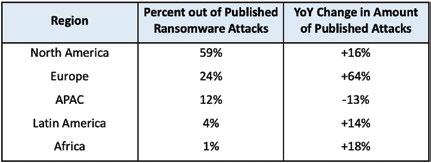
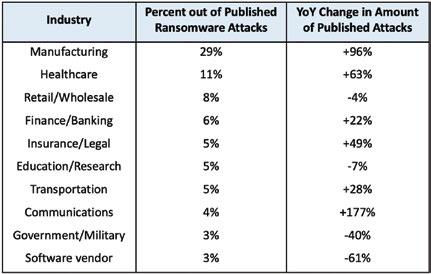
robust data backups, frequent cyber awareness training, timely security patches, strong user authentication, and advanced anti-ransomware solutions. Proactive engagement with AI-powered defences can significantly bolster an organisation’s resilience against these threats.
In response to these escalating threats which are becoming more sophisticated, advancements in defence techniques especially in threat detection and analysis and spotting anomalies and new attack patterns early, particularly in AI, have become pivotal.
For instance, Check Point’s ThreatCloud AI, which underpins all its solutions, leverages AI and big data to counter sophisticated threats, while minimising false positives. It processes vast amounts of data and indicators of compromise daily. A practical example of its effectiveness is in handling zero-day attacks.
A malicious link identified in the US is instantly blocked and this intelligence is shared globally, allowing a similar attack in Australia to be thwarted within seconds, averting potential harm.
The drive to defend continues
The first quarter of 2024 has underscored the need for adaptive cybersecurity strategies to combat the evolving threat landscape. The increased attacks on specific industries and regions, coupled with the complexity of ransomware tactics, highlight the necessity for comprehensive and prevention-first approaches to cybersecurity. While continuing to navigate this challenging terrain, awareness, preparedness and innovation in defence strategies remain the strongest allies.
(Check Point Software Technologies is a global leader in cybersecurity solutions.)
The Singapore Engineer (TSE): How has the threat landscape advanced in terms of critical infrastructure in Singapore?
Koh Ssu Han (KSH): Firstly, threat actors are bolder and have access to ever more powerful malware. Secondly, digital transformation has narrowed the gap between operational technology and IT systems. We are already seeing how these two factors are playing out. CyberArk found that 96% of the Singapore organisations surveyed experienced ransomware attacks between 2022 and 2023, and 60% of these were likely victims of double extortion campaigns.
Given the state of play, identities are crucial to restricting attacker movement within IT and OT networks, especially as cloud adoption or legacy app migration makes access ubiquitous.
TSE: What would be the repercussions of cyber-attacks on our critical infrastructures?
KSH: Critical infrastructure typically underpins sectors like healthcare and government facilities, as well as electric grids and water systems, which is why there are certain obligations involved with securing them.
Operators of critical infrastructure are also accelerating cloud adoption, which is expanding the attack surface. This is why it is also important to protect critical information infrastructure (CII). Singapore is constantly studying ways to do just this, which include the current tabling of a Cybersecurity (Amendment) Bill in Parliament, that requires the CII sectors to report more types of cybersecurity incidents, including those that happen in their supply chains, among other changes.
Certainly, this initiative is timely because attackers continually become
more adept at using new, advanced tools like Gen AI, to roll out faster and more sophisticated attacks, including identity-related attacks. Indeed, 67% of global respondents surveyed in the energy and utilities sector told CyberArk they were inadequately prepared to withstand attacks.
TSE: How can critical infrastructures adopt a proactive approach to cyber defence through identity security?
KSH: The big challenge is, of course, understanding the role that identities play in an attack. Simply put, access to key assets is what attackers want. Organisations know this. That is why they overwhelmingly told a CyberArk survey that they expect their organisations to suffer identity-related compromise.
An identity-centric risk plan allows decision-makers to figure out what is most valuable to their organisations and ensure that they are at the heart of the cyber strategy. This riskbased approach provides the backbone for zero trust and strengthens defences and compliance.
TSE: What is ‘zero trust’ and how can organisations adopt it to defend themselves effectively against such attacks?
KSH: Zero trust is centred on the belief that organisations should not automatically trust anything, whether it is outside or inside their network perimeter. Zero trust models demand that anyone and everything trying to connect to an organisation’s systems must first be verified before access is granted. The ‘assume breach’ mentality shifts the focus to identifying, isolating and stopping threats by scrutinising behaviour. This eliminates unnecessary privileges and strategically removes excessive permissions.

These principles can be upheld using more modern methods of identity security including strong adaptive authentication, zero standing privillege (ZSP), among others, that ensure users are who they say they are and are accessing their systems with ‘just right’ privileges required for performing their tasks, thus reducing risk to the organisation. Meanwhile, through automated identity provisioning, organisations can uphold zero trust as they can continuously approve and authorise identities. Another key element in implementing zero trust is securing authentication tokens while removing local administration rights. Organisations should also equip themselves with tools to maintain compliance with recorded key events and tamper-resistant audits. This also includes being able to secure and centrally store session recordings for easy security, audit and compliance, to increase accountability and compliance.
Singapore, represented by the Cyber Security Agency of Singapore (CSA), has been working closely with ASEAN Member States (AMS) to establish the ASEAN Regional Computer Emergency Response Team (CERT) to promote and facilitate information-sharing related to cyber incident response, and to complement the efforts by national national CERTs in each AMS. Singapore had made the recommendation for a single AMS to host the ASEAN Regional CERT and proposed to host and fund its physical activities in Singapore.
The benefits include lower costs and improved sustainability.
In many industries, shot blasting is an indispensable surface treatment process. It is an excellent tool for surface cleaning, deburring, surface preparation for painting or coating and shot peening. As such, shot blasting technology is used to create optimal surface finishes, be it to ensure problem-free downstream manufacturing operations or to optimise the functional characteristics of a product.
With shot blasting and any other industrial processes, customers face the challenge of improving productivity and cost-efficiency, as well as minimising the use of valuable resources.
Rösler fulfills these requirements, among other things, by utilising ultra-modern simulation software. In addition, virtual models significantly reduce the time for engineering – especially for large, complex machinery – and ensure that the equipment is available within shorter lead times.
With the Rösler simulation software, every physical stage of the shot blasting process, and the respective work pieces, can be displayed in a 3D model. This includes the blast media type, the thrown media quantity and the media flow. The data generated by the so-called particle simulation allows a precise evaluation of how much blast media is required and the impact energy with which it must hit different work piece surface areas to achieve 100% coverage.
At the same time, the data helps determine the required turbine power, the ideal position of the turbines and the design of suitable work piece fixtures. The simulations facilitate the development of shot blasting machinery and processes
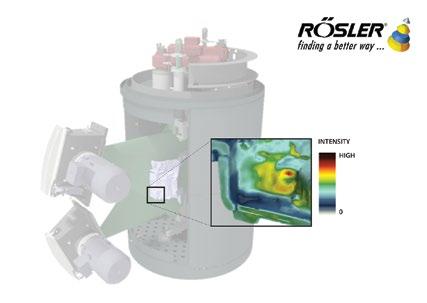
Completely quantified simulation of shot blasting processes.
for achieving optimal shot blasting results with the lowest number of turbines, low energy input and minimal machine wear. They also help reduce capital expenditures, operating costs and use of valuable resources.
Another benefit of simulations is that shot blast machinery for new work pieces can be planned on the basis of CAD data, well before the actual work pieces are available in prototype form. This saves precious time, because a shot blast machine can start productive operation at the same date it is commissioned. Time-consuming and costly processing trials with actual work pieces are more or less eliminated.
Moreover, the simulations also provide valuable insights as to whether the specified blast results can be achieved on work pieces with a given geometry. Should this not be possible, the simulation results provide valuable pointers regarding the optimisation of the work piece shapes.
The use of complex equipment Planning the introduction of, and commissioning complex, big shot blasting machines for treating components with large dimensions, for example, 20 m x 5 m x 4 m (L x W x H), are particularly challenging. Usually, for such large work pieces, practically no machines are available for running processing trials. In such cases, simulation and virtual planning of the shot blasting processes may be the only tool available for achieving good blasting results and high equipment efficiency.
For this purpose, Rösler developed another software module that models large, complex equipment and the respective shot blasting processes. On the one hand, the realistic and correct depiction of the blast patterns and the underlying media flow substantially reduces the overall investment risk. On the other hand, the time needed for planning and commissioning a shot blast machine can be shortened.
Faster processing
When it comes to shot blasting entire batches of relatively small work pieces, for example, in Rösler Multi-Tumbler (RMT) blast machines, the optimal mixing of work pieces and blast media can significantly influence the processing results and cycle times.
For such applications, the software allows the simulation and optimisation of the tumbling action of the work pieces in the drum-shaped blast chamber. This will result in the shortest possible process times. In some cases, cycle time reductions of around 25 % per batch could be achieved, resulting in a considerable capacity increase.
Energy-saving dust collectors
In shot blasting machines, the turbines and dust collectors require, by far, the highest energy input. This applies to standard as well as large shot blasting machines. Therefore, the software package also includes a special air flow simulation module that determines the air volume required to safely evacuate the dust generated during the blasting operation from the blasting chamber. If the dust can be evacuated more effectively by an improved air flow, it is possible that a smaller dust collector can be utilised, resulting in lower energy consumption. In any case, an optimised air evacuation system helps reduce cycle times and therefore increases productivity. Furthermore, the work pieces leave the shot blasting machine cleaner, thus facilitating downstream manufacturing operations.
Increased operational efficiency with digital twins
Rösler works with digital twins of the blast turbines, to reduce their energy consumption and wear rate and, at the same time, increase their operational efficiency. The replication of the particle flow provides a virtual analysis of the wear areas in a turbine. This, in turn, allows the implementation of geometrical turbine modifications for minimising the wear rate.
Other simulations can be con-
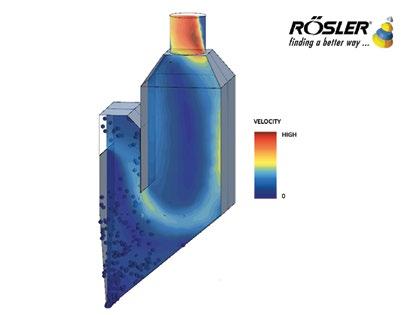
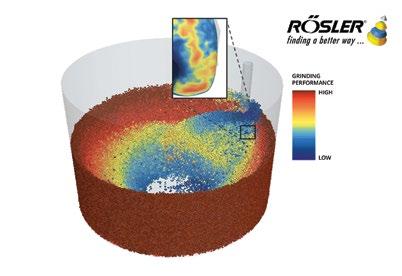
ducted with the goal of increasing the turbine efficiency which will result in additional energy savings. Thanks to the broad application of simulation software for the design of shot blasting equipment and the respective processes, as well as for the optimisation of the airflow and turbine technology, the lead times for Rösler shot blasting machines are substantially shortened. Moreover, they produce considerable energy savings and have a lower wear rate. All this results in significant customer benefits.
Finishing of complex work pieces
To-date, the development of mass finishing processes for single piece processing of geometrically complex and difficult-to-machine work pieces, such as knee implants, required numerous processing trials. For such elaborate applications, usually handled in so-called drag finishers, Rösler is also utilising simulation technologies.
Antti Wikström, Global Product Manager for Solid End Mills – Roughing, at metal cutting specialist, Sandvik Coromant, explains how the shortcomings in machine shops, in terms of tool life, productivity and process security, can be overcome.
Machine shops always seek to enhance productivity, improve efficiency, and cut costs, driven by market demands and the constant push to stay competitive. Solid carbide end mills for roughing are one solution to these needs, but many existing tools on the market show limitations in performance – both in tool life, productivity and process security.
The Financial Times has identified inflation and the Ukraine war as major factors that have caused rising energy and raw material prices, including for steel. These escalating costs pose a significant obstacle for manufacturers in terms of achieving a low cost-per-part, and directly impact manufacturers’ profitability.
How can manufacturers be overcoming these obstacles in their machining applications, while meeting market demands and staying competitive?
One solution is by applying a power cut machining strategy which has emerged as a highly effective approach for roughing operations. Such a strategy ensures efficient metal removal rates and excellent process security. With an effective power cut strategy, manufacturers can optimise roughing operations, boosting productivity and reducing cycle times.
But how should a power cut strategy be applied? Put simply, the method is similar to high feed side milling (HFSM) but with a larger radial width of cut, still benefitting from a controlled engagement and tool load. To be performed successfully, the method entails a constant high radial engagement and smooth motions during machining – both of which contribute towards enhanced process security, tool life and productivity.
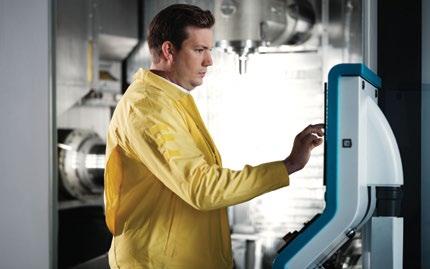
Manufacturers need to overcome the obstacles in their machining application, in order to stay competitive.
Before we look at the power cut strategy, let us briefly examine two conventional options for roughing. First, there is the picture frame strategy, an old roughing strategy with an inefficient tool path.
Benefits of a picture frame strategy include not needing to update NC programs and that the programs are small. This is beneficial for old machines with limited memory and processing capabilities.
Disadvantages include not being able to utilise the full potential of the cutting tool on the ‘easy parts’ of the tool path, and overloading the cutting tool – in the corners, for example. The results are poor, in all aspects of machining performance (tool life, productivity, process security, quality of the machined part and machine tool wear/ maintenance).
Next is the aforementioned HFSM strategy, an efficient and high performing strategy that utilises the full performance of the tool with high process security and tool life. HSFM tools normally have a very high den-
sity of teeth, which is very beneficial for tool life as well as productivity when machining with small radial engagement which also allows for a very high axial depth of cut.
However, these tools are not suitable at all for larger radial engagements and, even if they are applied with shorter axial depth of cut, will break. If a Double Depth of Cut (2xDC), or less, is needed then a power cut strategy becomes more efficient.
Tools designed for larger engagements are necessary to achieve this. That is why Sandvik Coromant’s engineers sought to develop an optimised and effective solid carbide end mill that would excel in this area.
The result was CoroMill Plura HD and now the next generation has been launched with two new grades.
Higher metal removal rates
CoroMill Plura HD is offered in two different grades and coatings, and both have been upgraded. One of the new grades is P2BM for steel. The other new grade is M2CM for stainless steel. The larger radial en-
gagement allows for higher material removal rates (MRR) than HFS in applications, and this advantage can be achieved up to 2xDC. The result is increased material removal in a single pass.
For the new grades, Sandvik Coromant’s R&D specialists have created new coatings for solid carbide end mills that can improve tool life. At the same time, cutting speeds are increased. The new coating technology, called Zertivo 2.0, offers better resistance to heat and abrasive wear without compromising on toughness.
In short, the Zertivo 2.0 coatings contribute by offering a very resilient cutting edge. Both versions of CoroMill Plura HD, the P2BM and M2CM grade variants, use the Zertivo 2.0 technology.
A power cut strategy allows for 70% to 90% radial engagement, enabling around 10 passes at once, compared to a HFSM strategy, since HFSM typically employs a radial engagement of 5% to 10% of the tool diameter. However, it is worth noting that HFSM can be used with very large axial depth of cuts, whereas the power cut strategy has a limit of two times the cutter diameter for the axial depth of cut.
By using the power cut strategy within its working area, which extends up to two times the cutter diameter, manufacturers can achieve high metal removal rates while maintaining process stability. The controlled engagement and load ensure the stability of the cutting process, reducing the risk of tool breakage or other issues.
Performance tests
CoroMill Plura HD and Zertivo 2.0 were assessed in extensive performance tests against competing solid carbide end mills.
One out of the many cases where Plura HD has proven its performance is in slot milling a 1.4404 (316L) stainless steel ISO-M component. The M2CM grade CoroMill Plura HD and a competing end mill were run at the same machining parameters – a cutting speed (Vc) of 90 m/min, feed per tooth (fz) of 0.05 mm/tooth, radial width of cut (ae) of 10 mm and
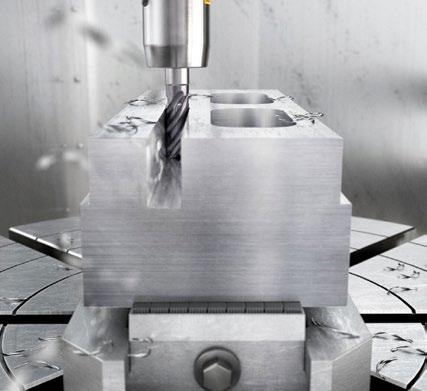
axial depth of cut (ap) of 5 mm. In the end, CoroMill Plura HD exhibited a +65% tool life increase over the competing solid carbide end mill.
Another example is where the P2BM CoroMill Plura HD end mill was put to work against another competing tool on a SS1672 (C45) 160 HB steel ISO-P component, this time to perform the heavy machining application of dry shoulder milling. The following cutting parameters were used – a Vc of 235 m/min, fez of 0.1 mm/tooth, ae of 7.5 mm and ap of 5 mm. In this instance, the P2BM grade CoroMill Plura HD exhibited a tool life increase of +150%.
The performance advantages of CoroMill Plura HD and Zertivo 2.0 are especially beneficial for machine shops in all sectors that are looking to manufacture products more easily, efficiently, and cost-effectively. The standard assortment offers diameters from 2 mm to 25 mm, a 2×D depth of cut, 4 to 5 teeth and a ramping angle of 5° or 7°.
Overall, the Sandvik Coromant tool was found to achieve a 30% improved tool life and 30% improved productivity, at the same time. This was achieved both for the
new stainless steel tools in ISO-M machining and for the steel tools in ISO-P machining.
It should be noted that these results were accomplished without applying strategy improvements, such as a power cut strategy that would optimise the performance even further.
In conclusion, Sandvik Coromant’s CoroMill Plura HD solid carbide end mill is a strong performing tool that brings large performance improvements also in less favourable operations. The end mill contributes to large improvements both in tool life and in productivity in comparison with competing tools. With its Zertivo 2.0 coating, the product family improves process security, tool life and productivity compared to old generation grades and competing tools.
That said, CoroMill Plura HD’s performance can be lifted even higher by applying a power cut strategy. This can improve process security, tool life and productivity even further. By adding a power cut strategy, CoroMill Plura HD’s performance will be multiplied again.
Stringent safety protocols and advanced technology ensure the well-being of passengers.


Aptly named ‘Whoosh’, Indonesia’s newly opened high-speed rail marks a significant milestone in Southeast Asia’s transportation history. The first bullet train to operate in the region, the Whoosh travels 142 km across four stations and connects Jakarta, the capital city of Indonesia, with Bandung, the populous capital of West Java province.
Capable of operating at speeds of up to 350 km per hour, it comprises eight cars and a capacity of 601 passengers, providing ample space for commuters and travellers alike. The use of electrical energy in the rail line’s operations also contributes to reducing carbon emissions, making it an environmentally friendly mode of transportation.
With cutting-edge technology and infrastructure to ensure a smooth and efficient travel experience for passengers, how do contractors ensure the safety of passengers on
bullet trains that travel at breakneck speeds?
Safety is of paramount importance for high-speed rail systems, and extensive measures are in place to ensure the well-being of passengers. High-speed rail systems adhere to stringent safety protocols and incorporate advanced technology to mitigate risks.
Bullet trains are equipped with a braking system that can safely bring a train travelling at speeds higher than 300 km per hour to a stop. Under normal circumstances, bullet trains such as the Superconducting Maglev rely on regenerative braking. This form of breaking involves using linear motors as generators to slow down the train. The kinetic energy of the vehicle is converted into electrical energy,
which is then fed back into power conversion equipment for reuse.
In emergency situations, the bullet train relies on wheel disc braking. Different from regenerative breaking, it uses disc braking equipment installed on the train’s wheels to mechanically bring the train to a halt. Aerodynamic braking is another braking system used in emergency situations, where air drag panels are deployed from the vehicle to utilise air resistance for slowing down. It generates a notably significant deceleration effect when travelling at high velocities.
All braking systems undergo rigorous testing in challenging scenarios to ensure operational safety. One example is the testing done on the Yamanashi Maglev Line, where braking systems have been examined for the unlikely event of needing to transition away from operating speeds of over 300 km per hour.
From 2000 to 2020, there were 4,245 minor earthquakes, 38,092 light earthquakes, and 4,163 moderate earthquakes within the Indonesian territory. Japan is in a similar plight with earthquakes and technology has been in place within bullet train systems as countermeasures for earthquakes.
For example, the Earthquake Rapid Alarm System has already proven successful in Japan. In order to reduce the damage caused by earthquakes, JR East has installed earthquake early detection systems (Compact UrEDAS) in all Shinkansen trains to quickly and automatically bring them to an emergency stop when earthquakes occur.
As these trains utilise magnets and levitation, the vehicle operates without any physical contact with the rail, floating approximately 3.9 inches above the ground inside a U-shaped guideway. Using magnetic force generated by levitation and guidance coils, the vehicle remains centred within the guideway, ensuring both vertical and horizontal stability and preventing any possibility of derailment during an earthquake.
When the train veers off-centre in the guideway, the side of the guideway that is farther from the train experiences an attractive force, while the side closer to the train experiences a repulsive force. This phenomenon is based on the principle of electromagnetic induction and ensures that the vehicle is always brought back to the centre of the guideway without any need for human intervention. The force exerted by this mechanism increases as the train’s speed increases, enhancing overall stability.
To mitigate the risk of fires, Japanese bullet trains are constructed using materials that are non-flammable and flame-retardant, meeting the flammability specifications outlined in Japan’s Ministry of Land, Infrastructure, Transport and Tourism ordinance. Additionally, fire extinguishers are strategically placed

in each car for immediate response to any potential fires.
Partition doors are installed at both ends of the trainset, and automatic gangway connections are provided between individual cars. In the event of a fire, the train will continue to the next stop or exit a tunnel before coming to a halt, ensuring swift and safe evacuation of passengers as a priority.
As the world becomes increasingly digitalised, rail safety solutions have also seen a shift towards automated solutions. HIMA, a German company specialising in automation and safety solutions, plays a crucial role in ensuring the safety of high-speed rail systems worldwide. With Commercial-Off-The-Shelf (COTS) solutions, HIMA provides reliable and efficient safety controllers that can be easily installed and maintained.
All HIMA controllers, such as the HIMatrix and HIMax, comply with the strict SIL 4 standard set by CENELEC, ensuring the highest level of safety for railway applications. They are equipped with advanced features and functionalities that enable real-time monitoring, fault detection and emergency shutdown.
HIMA’s solutions have been in use by Indonesia’s PT Len Railway Systems (LRS), where solutions are flexible and scalable. By utilising standardised components, controllers are readily available and can be quickly supplied with spare parts when needed. This minimises downtime and maximises the availability and operational efficiency of high-speed rail systems.
In conclusion, the introduction of the Whoosh high-speed rail in Southeast Asia represents a significant leap forward in transportation infrastructure. With its impressive specifications, including high speeds and reduced travel times, the Whoosh rail line has transformed the way people travel between Jakarta and Bandung.
Furthermore, the commitment to safety on high-speed rails, demonstrated through rigorous maintenance and innovative technology ensures a safe and secure journey for passengers. The collaboration between high-speed rail operators and companies like HIMA further enhances rail safety, providing confidence in the reliability and efficiency of these modern transportation systems.
Twelve initiatives and five enablers to decarbonise Singapore’s aviation sector.
The Singapore Sustainable Air Hub Blueprint was launched by Mr Chee Hong Tat, Minister for Transport and Second Minister for Finance, at the Changi Aviation Summit. The blueprint, which was developed by the Civil Aviation Authority of Singapore (CAAS), in consultation with industry and other stakeholders, sets out Singapore’s action plan for the decarbonisation of its aviation sector. It has been submitted to the International Civil Aviation Organization (ICAO) as Singapore’s State Action Plan.
The blueprint adopts a balanced approach to the long-term, sustainable growth of Singapore’s aviation sector, taking into account the need for environmental sustainability while ensuring that the Singapore air hub remains competitive. It sets out Singapore’s medium-term and long-term targets, as well as concrete steps that CAAS and the aviation stakeholders will take to decarbonise Singapore aviation.
Under the blueprint, CAAS will work with aviation stakeholders to reduce domestic aviation emissions from airport operations by 20% from 2019 levels (404ktCO2e) in 2030 and achieve net zero domestic and international aviation emissions by 2050. To achieve these goals, 12 initiatives across the airport, airline and air traffic management (ATM) domains will be rolled out to decarbonise the Singapore aviation sector. CAAS will also put in place five enablers to create the conditions for the effective implementation of these initiatives.
Domestic aviation emissions from airport operations include emissions from the operations of vehicles, facilities and buildings for aircraft, passenger, baggage, and cargo handling at Changi and Seletar airports. It does not include targets for Changi East developments,
including Terminal 5, which are not yet operational today. These will be determined separately.
International aviation emissions include emissions from international flights operated by Singapore-based operators.
Airport domain
CAAS will advance five initiatives to reduce energy use and deploy renewables at the airport. Of note, CAAS will work with Changi Airport Group to increase solar power deployment at Changi and Seletar Airports. CAAS will also work with the Changi Airport community to expand the use of cleaner energy for airside vehicles.
In 2024, CAAS will work with stakeholders to commence a trial on the use of renewable diesel for airside vehicles, particularly heavy and specialised vehicles, to better understand the feasibility, cost and operational impact of using renewable diesel as a cleaner energy source for airside vehicles. The other initiatives include improving building energy efficiency, leveraging low-carbon electricity imports and exploring the feasibility of an on-site waste-to-energy facility for resource circularity.
Airline domain
CAAS will undertake four initiatives to build a Sustainable Aviation Fuels (SAF) ecosystem to support the use of SAF in Singapore and to progressively decarbonise airline operations.
Of note, the use of SAF will be required for flights departing Singapore from 2026, and a SAF levy will be introduced to achieve the SAF uplift target. The use of SAF is a critical pathway for the decarbonisation of aviation and is expected to contribute around 65% of the carbon emission reduction needed to achieve net zero by 2050.
To kickstart SAF adoption in Singapore, flights departing Singapore will be required to use SAF from 2026. The aim is for a 1% SAF target for a start, to encourage investment in SAF production and develop an ecosystem for more resilient and affordable supply. The goal is to raise the SAF target beyond 1% in 2026 to 3% to 5% by 2030, subject to global developments and the wider availability and adoption of SAF.
The levy that CAAS will introduce for the purchase of SAF to achieve the uplift target, will vary based on factors such as distance travelled and class of travel. CAAS will continue its close consultation with stakeholders on the implementation of the SAF levy, before announcing more details in 2025 nearer the date of implementation.
Other initiatives under the airline domain include the centralised procurement of SAF for the Singapore air hub, anchoring SAF production in Singapore and the region, and investing in airline fleet renewal and operational improvements.
Air Traffic Management domain
CAAS will undertake three initiatives to improve Air Traffic Management (ATM) operations to increase efficiency and reduce fuel burn over the next five years. This includes advanced demand-capacity balancing implementation, performance-based navigation enhancements, and gate-to-gate trajectory optimisation. Collectively, these initiatives are expected to bring about a 10% reduction in additional fuel burn and emissions, offering a winwin solution for the environment, airlines and passengers.
To enable these ATM initiatives, CAAS is collaborating with local and international stakeholders, such as airlines, other air navigation service providers, the recently established
International Centre for Aviation Innovation (ICAI), as well as local research institutes and institutes of higher learning, to develop and trial the solutions.
CAAS will also put in place five enablers to create the conditions for the effective implementation of these decarbonisation initiatives. They include policy and regulation, industry development, infrastructure planning and provision, workforce transformation, and international partnerships and collaborations.
Of note, CAAS has rolled out a SGD 50 million Aviation Sustainability Programme to support sustainable aviation projects, will build up sustainability capabilities in the workforce, and establish the Asia-Pacific sustainable aviation centre.
The Sustainable Air Hub Blueprint has incorporated and built upon the recommendations by the International Advisory Panel (IAP) on Sus-
tainable Air Hub, which were published in September 2022. The IAP, formed in February 2022, brought together 20 industry, technology, and knowledge partners from Singapore and around the world.
The IAP was chaired by Professor Chong Tow Chong, President of Singapore University of Technology and Design. Members of the IAP include Directors-General from key international aviation organisations, as well as C-suite executives from major aviation industry and renowned knowledge and technology partners. Following the submission of the IAP recommendations, CAAS and stakeholders held extensive consultations and conducted detailed studies before finalising the targets and initiatives of the blueprint.
Mr Chee Hong Tat, Minister for Transport and Second Minister for Finance, said, “Singapore’s approach is to enable the aviation sector to achieve both growth and environmental sustainability, so
ST Engineering announced that its Commercial Aerospace business has extended its partnership with Honeywell for mechanical, avionics and LEAP engine components service and repair, as a member of the Honeywell Channel Partner network.
Under the partnership extension, ST Engineering will continue to be a licensed repair centre for Honeywell's components, and use the latter’s advanced technologies and software solutions to provide one-stop component repair and overhaul services for operators worldwide.
ST Engineering became a member of the Honeywell Channel Partner network in 2019, which gives it access to Honeywell’s maintenance document and technical support for over 700 individual part numbers, from avionics to electrical and mechanical components.
In addition to being part of the Honeywell Channel Partner network, ST Engineering is also the only licensed maintenance, repair and overhaul (MRO) service provider based in Asia Pacific for Honeywell components installed on the LEAP-series engines.
Mr Goh Poh Loh, Executive Vice President and Head of Component Services, ST Engineering, said, “ST Engineering and Honeywell have had a longstanding partnership that is committed to delivering the highest possible levels of component support to airlines and operators. With the renewal of our collaboration with Honeywell, ST Engineering will continue to live up to its strong value proposition of providing fleet maintenance solutions that are enhanced with OEM support and resources.”
As the authorised service centre to over 15 leading OEMs,
that future generations can continue to enjoy the benefits of flying. The Singapore Sustainable Air Hub Blueprint demonstrates this balanced approach. The measures were developed after careful study and close consultation with domestic and international stakeholders, and we hope that they will help to catalyse the development of sustainable aviation in the region and around the world.”
The mission of the Civil Aviation Authority of Singapore (CAAS) is to grow a safe, vibrant air hub and civil aviation system, making a key contribution to Singapore’s success. CAAS’ roles are to oversee and promote safety in the aviation industry, develop the air hub and aviation industry, provide air navigation services, provide aviation training for human resource development, and contribute to the development of international civil aviation.
ST Engineering supports more than 1,000 aircraft and provides integrated component solutions for over 23,500 unique aircraft parts.
Its Commercial Aerospace business provides round-the-clock support and delivers more than 80,000 components annually from its component MRO facilities located in Asia and Europe. Its global nacelle MRO services currently operate out of facilities located in the US, Asia and Europe.
ST Engineering is a global technology, defence and engineering group with a diverse portfolio of businesses across the aerospace, smart city, defence and public security segments. Headquartered in Singapore, it has operations spanning Asia, Europe, the Middle East and the US, serving customers in more than 100 countries.
This signals a renewed optimism and recovery in aviation.
Singapore Airshow 2024, Asia’s most influential aerospace and defence event, announced an unparallelled trade attendee turnout at its ninth edition that was held at the Changi Exhibition Centre from 20 to 23 February 2024.
The record number of close to 60,000 trade attendees, a 10% increase compared to the previous high in the 2018 edition, signals a renewed optimism and recovery in the aerospace landscape in the Asia Pacific region, that is expected to account for over 45% of new aircraft deliveries forecast to take place between 2023 and 2042.
Since its inception in 2008, Singapore Airshow has served as a platform that fosters collaboration and helps chart a transformative course for the aerospace and defence industry.
Each edition welcomes industry leaders, government officials and military delegations, who converge at the Changi Exhibition Centre to network and exchange ideas.
“We are delighted to announce this overwhelming response for this edition. It clearly signals a renewed optimism and momentum driving the sector forward. It certainly reaffirms Singapore Airshow’s role as a catalytic platform for industry professionals in the global arena, to convene and draw up tomorrow’s agenda,” said Mr Leck Chet Lam, Managing Director, Experia, organiser of Singapore Airshow.
AeroForum, Singapore Airshow’s thought-leadership forum, which hosted the largest volume of strategic conversations across nine panel discussions that presented 36 panel speakers and 10 moderators, was attended by close to 600 trade attendees.
Organised in collaboration with five esteemed industry partners

– Alton Aviation Consultancy, Association of Aerospace Industries (Singapore), Chinese Society of Aeronautics and Astronautics, Flight Global, and McKinsey & Company – a wide range of topics spanning aviation leadership, sustainable aviation, advanced air mobility and China-Singapore bilateral aviation were discussed.
As a key platform for meetings and collaborations, Singapore Airshow also saw several major announcements made during the four trade days, including several that focused on meeting decarbonisation targets.
Airbus showcased its commitment to carbon neutrality by 2050, advocating accelerated progress in sustainable aviation fuel production and unveiling plans in an agreement with TotalEnergies which will supply Airbus with SAF (sustainable aviation fuel) for more than half of its needs in Europe. Airbus also announced plans for a hydrogen-powered aircraft slated for operational debut by 2035.
Singapore's proposal to introduce a levy to support sustainable aviation fuel sparked extensive dis-
cussion, reflecting the industry's determination to meet its 2050 net-zero emission goal. Boeing outlined its plans for autonomous flights by 2030, while Embraer announced a strategic partnership with Scoot, making the airline the first in the Asia Pacific to adopt Embraer's Collaborative Inventory Planning solution, a tailored expendable spare parts management programme that ‘optimises’ inventory levels for customers to reduce operational costs.
Several Asia-based airlines also placed aircraft orders. Starlux Airlines placed an order for five Airbus A350 freighters and three A330neo widebody passenger jets to support its fleet expansion.
Vietjet Air signed a Memorandum of Understanding (MoU) with Airbus to purchase 20 A330-900 widebodies. The international debut of China’s ARJ21 and C919 jet by Commercial Aircraft Corp of China (COMAC) garnered significant attention, with Tibet Airlines signing a 50-plane deal. Thai Airways and Royal Brunei Airlines also announced orders for 45 and four Boeing 787 Dreamliners, respectively.
The objective is to build a robust and environment-friendly aviation ecosystem.
Airbus has signed a Memorandum of Understanding (MoU) with the Singapore Economic Development Board (EDB) to facilitate the establishment of a Sustainable Aviation Hub with a specific focus on technology, research and innovation.
Under this MoU, both parties intend to enter into discussions to facilitate Airbus’ establishment of the Sustainable Aviation Hub in Singapore. The hub will bring together aerospace professionals, researchers, and innovators to create a collaborative environment that promotes research and development aimed at building a robust and environmentally sustainable aviation ecosystem. The hub will focus on the following key areas of development:
• Decarbonising Aviation: To support the global transition towards decarbonised aviation, the hub will focus on research and analysis of the Sustainable Aviation Fuel (SAF) supply chain and hydrogen-based technologies.
• Maintenance, Services, and Operations: The hub will focus on advancing maintenance, services and operations within the aerospace industry, leveraging cutting-edge technologies and best practices.
• Air Traffic Management and Unmanned Air Traffic Management: The hub will work on projects aimed at modernising and improving air traffic management (ATM) systems, as well as the emerging field of unmanned air traffic management (UTM).
This project includes the design, development, and the test and validation of sustainable next-generation aviation technologies and best practices in the industry. The Sustainable Aviation Hub will be hosted within Airbus’ Singapore Campus in
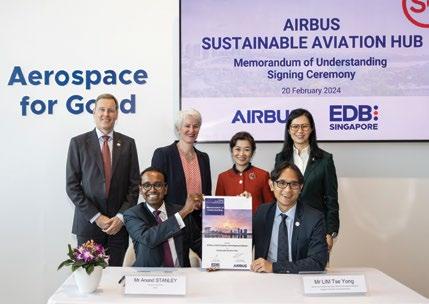
Seletar Aerospace Park.
A priority for the hub is to work in close collaboration with the local enterprises, universities and research institutions to facilitate knowledge exchange, talent development and joint research initiatives. A comprehensive talent development programme will also be established to nurture local aerospace professionals, researchers and innovators, through internships and training courses with, and through joint programmes drawing the support of, Airbus’ global research teams.
“Singapore is home to Airbus’ Asia-Pacific headquarters, given its strategic location, pro-innovation policies, highly skilled workforce and strong research capabilities. It therefore is an ideal choice to spearhead such an initiative here. This project aligns with the Airbus commitment to lead the decarbonisation of the aerospace sector. We look forward to exploring together
to develop new technologies and invest in solutions for low carbon aviation,” said Sabine Klauke, Chief Technology Officer, Airbus.
“The Airbus Sustainable Aviation Hub represents another milestone in Singapore’s longstanding partnership with Airbus. Making aviation greener is an important component in decarbonising our planet. Singapore is partnering with leading aerospace companies to drive technology, research and innovation, and talent development, to support the sustainable growth of the aviation industry,” said Ms Jacqueline Poh, Managing Director, Singapore Economic Development Board.
The longstanding collaborative relationship between Airbus and EDB which started nearly two decades ago, is a driving force behind this joint commitment to support the launch of the Sustainable Aviation Hub in Singapore.
The necessary technologies, regulations, infrastructure and supply chains are being developed.
The Singapore Hydrogen Cooperation Committee sees hydrogen fuel playing a potential role in the state’s aviation decarbonisation journey.
The working group was formed, following the signing of the Cooperation Agreement by Airbus, Changi Airport Group, Civil Aviation Authority of Singapore (CAAS), and Linde, in February 2022. Since then, the committee has examined regional and local market demand and supply for hydrogen, the hydrogen supply chain and infrastructure requirements, and the potential considerations for establishing a successful hydrogen ecosystem for aviation in the city-state.
The technology to use liquid hydrogen to power aircraft is currently under development and will only be applied on future generations of large commercial aircraft. The early technical feasibility study undertaken by the committee is useful to ensure that when the technology becomes mature and feasible, Singapore will be well prepared to incorporate liquid hydrogen as part of its aviation decarbonisation strategy.
“Stakeholders in the Asia-Pacific region are increasingly taking greater interest in making significant investments into hydrogen, developing new technologies and establishing supply chains. Together with our partners, we recognise the potential of hydrogen becoming a longer-term decarbonisation pathway for aircraft operations, complementing sustainable aviation fuel, in support of our transition towards net zero by 2050,” said Ms Sabine Klauke, Chief Technology Officer, Airbus.
As part of the study, the committee has identified infrastructure scenarios that could support the progressive deployment of a largescale supply of liquid hydrogen for aviation at Changi Airport in the longer term future. Singapore’s avi-
ation sector may consume up to 50 tonnes of liquid hydrogen daily from the 2040s, and up to 600 tonnes per day beyond 2050. These scenarios are based on future hydrogen aircraft with capacities of 100 to 200 passengers, and an operating range of 1000 to 2000 nautical miles (NMs), entering service between 2035 and 2040, in Singapore.
While a 2,000 NM range from Singapore’s Changi Airport would allow an aircraft to reach about 74 airports in 20 Asia-Pacific countries and territories, the committee highlighted that other key factors such as the hydrogen readiness levels at potential destination airports and airlines’ commercial considerations would also be important to realise the eventual hydrogen-powered flights between Changi Airport and other airports in the region.
Mr Han Kok Juan, Director-General of CAAS, said, “The International Civil Aviation Organization Member States have adopted a collective long-term global aspirational goal of net-zero carbon emissions by 2050. While the near-term focus is on the wider adoption of sustainable aviation fuels in aircraft operations, hydrogen can potentially play a complementary role as a sustainable energy fuel in the longer term.”
“CAAS has shared some of the key findings from the study with relevant government agencies for longer-term national planning for demand of hydrogen and will continue to monitor signposts around the development of hydrogen technology for aircraft operations,” he added.
Ms Poh Li San, Senior Vice President, Terminal 5 Specialised Systems, Changi Airport Group, said, “Hydrogen technology is still in its nascency, with many uncertainties and the industry is working hard to study aspects such as operations, safety, regulation and economics.
These need to be examined further. As the aviation industry progresses on its sustainability journey, it is prudent to take a phased approach as air hubs study how best to support the use of hydrogen by aircraft.”
“Hydrogen has a key role to play in the global clean energy transition. In aviation, hydrogen shows promise on two fronts – reducing aircraft emissions in the air, and decarbonising airside ground activities. Linde has over 100 years of experience with hydrogen. Our business spans the entire global hydrogen value chain and we look forward to leveraging our capabilities to further develop the promise of hydrogen in aviation,” said John Panikar, EVP and CEO APAC, Linde.
The committee also agreed that it is important to continue monitoring the following:
• Technology: Monitor hydrogen aircraft technology maturity and develop related signposts, including the launch of Airbus’ ZEROe aircraft demonstrator in 2027.
• Concept of Operations (CONOPs): Monitor development of associated CONOPs for logistics, storage, onsite distribution and refuelling of liquid hydrogen in an airport environment.
• Regulations: Monitor development of safety regulatory frameworks and standards for the use of liquid hydrogen for aircraft operations.
• Hydrogen Supply Chain and Airport Infrastructure: Monitor development of robust and commercial-scale liquid hydrogen supply chain compatible with an airport (from import, storage, and onward distribution network to aircraft).
• Readiness of other airports for liquid hydrogen aircraft operations.
• Relative price of liquid hydrogen as an alternative aircraft fuel.
Over 30 innovations implemented to accelerate MRO performance.
Pratt & Whitney, an RTX business announced significant progress in advancing maintenance, repair, and overhaul (MRO) performance, spearheaded by the opening of its Singapore Technology Accelerator (STA).
In September 2022, Pratt & Whitney announced the intent to establish the technology accelerator in collaboration with the Singapore Economic Development Board (EDB). STA has since delivered over 30 innovations which will maximise the productivity in MRO processes. STA is also working with more than 20 Singapore companies to develop new, relevant technologies in the global commercial aviation sector.
Applied across four Pratt & Whitney Singapore-based MRO facilities, STA technology projects focus on automation, advanced inspection, connected factory and digital twin, to improve shop performance.
“STA is a focal point for the innovative thinking and enterprising spirit of our employees, applied to scale technologies across our MRO facilities faster and better,” said Mr Gilbert Sim, Director, Aftermarket Global Operations Technology and CORE, Pratt & Whitney.
“We will continue working with MRO facilities and centres of excellence in Singapore and throughout the network to deliver more technology insertion projects. Together with our steadfast commitment to investments in MRO capacity, we are expanding our capabilities to support our customers around the world,” he added.
Pratt & Whitney is empowering both its own MRO operations and customers, with crucial insights into performance, quality, capacity, productivity and cost, through the ongoing digitalisation and automation of shop floors.
Through technology insertion projects like the innovations pioneered by

STA and validated at local facilities in Singapore, these innovations will be rolled out progressively across Pratt & Whitney’s global MRO footprint, to benefit customers with improved throughput and turnaround time.
Pratt & Whitney is also develop-
ing and deploying advanced repair capabilities via other centres of excellence around the world, including emerging fields like artificial intelligence and machine learning, to remain a leader in the evolving MRO and aviation landscape.
Pratt & Whitney announced a USD 20 million investment to grow its manufacturing capacity in Singapore for the production of Pratt & Whitney GTF engine high pressure turbine (HPT) disks. The capacity expansion is expected to increase the facility’s workforce by more than 10% over the next two years.
Pratt & Whitney’s Singapore facility currently produces 2,400 turbine disks annually, and the expansion is expected to increase annual output yield of the disks by approximately 45% by January 2026. The expansion will also improve the facility’s capacity to intake raw materials, maintain inventory, and keep production and deliveries on schedule.
“With this latest development, we are focused on automation and connectivity, as part of our
commitment to Industry 4.0 principles that aim to enhance operational efficiency and productivity,” said Mr Marc Paquet, General Manager for P&W NGPF Manufacturing Company Singapore Pte Ltd.
Pratt & Whitney’s Singapore manufacturing facility achieved full operational capability in June 2023, and plays a key role in the company’s production of critical components for the GTF engine family. The facility uses wallto-wall, closed-door machining and actively integrates the latest technology and automation into the manufacturing process.
The 20,500 m2 facility produces hybrid metallic fan blades and highly complex turbine components. The Singapore facility is a joint venture between Pratt & Whitney and Hanwha Aerospace Co Ltd.
Advanced technologies will be deployed to meet rising MRO demand.
Singapore Aero Engine Services Private Limited (SAESL), one of the world’s largest Rolls-Royce Trent engine maintenance, repair and overhaul (MRO) organisations, has announced its expansion, with new facilities and advanced technologies, to capture rising engine MRO demand and cement its position as a global leader in engine MRO.
SAESL is a joint venture between Rolls-Royce and SIA Engineering Company Limited (SIAEC), incorporated, in 1999, as an ongoing collaborative partnership.
With the aerospace sector rebounding post-pandemic, demand for MRO services is expected to grow significantly over the coming years. In 2024 alone, the Asia-Pacific region is expected to account for one-third of total global demand, which is expected to grow by 2% to 3%, to USD 657.23 billion (mrobusinesstoday.com).
The USD 180 million investment for the expansion will increase SAESL’s capacity by 40%. It will enable SAESL to expand its engine strip-and-build module repair and component repair capacity. It will also help SAESL to drive transformation through technology, by developing new MRO processes, core digital technology and Industry 4.0 capabilities.
Building new facilities and integrating advanced technologies The expansion involves the addition of new facilities with a combined footprint of over 50,000 m2. This comprises building a new 26,000 m2 facility at JTC’s Loyang estate, adjacent to the current SAESL campus at Calshot Road, and SAESL’s expansion into the Rolls-Royce campus in JTC’s Seletar Aerospace Park. The current facilities, across five buildings in Calshot Road and Loyang Road will be transformed and reconfigured to meet the expected increase in production capacity.
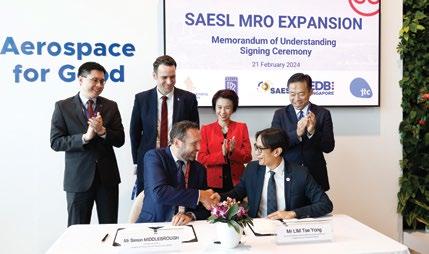
At the signing of the MoU for the expansion of Singapore Aero Engine Services Private Limited (SAESL) are, seated, from left, Mr Simon Middlebrough, CEO, SAESL and Mr Lim Tse Yong, Senior Vice President and Head, Mobility and Industrial Solutions, Singapore Economic Development Board (EDB). Looking on are, from left, Mr Chin Yau Seng, CEO, SIA Engineering Company (SIAEC); Mr Paul Keenan, Director of Global Aftermarket Operations, Rolls-Royce; Ms Low Yen Ling, Minister of State, Ministry of Trade and Industry and Ministry of Culture, Community and Youth; and Mr Png Cheong Boon, Chairman, EDB.
The new facility to be built at Calshot Road will focus on engine inductions and utilise state-of-theart logistics solutions to optimise engine parts management. The operations in the Seletar Campus will focus on large component repair, several commodity centres of excellence, and low-pressure turbine repair.
SAESL will establish an Advanced Repair Cell (ARC) that will focus on industrialising three core technologies – additive remanufacturing, adaptive machining and non-contact measurement systems. The ARC will be an agile and novel process-led cell – highly automated, harnessing the latest adaptive machining, 3D scanning, and additive and digital technologies tuned to the modern generation of gas turbine engines.
With the anticipated portfolio of new repair capabilities for some of Rolls-Royce’s high value engine components, SAESL is set to become the focal point for Rolls-Royce’s global MRO network in industrialising ad-
ditive and adaptive repairs.
SAESL’s expansion programme is planned to be progressively completed from 2026 onwards.
MoUs signed with leading agencies and partners
To solidify its support of Singapore as an aviation hub and ecosystem, SAESL has also signed Memoranda of Understanding (MoUs) with several agencies and partners over two days, at Singapore Airshow 2024.
SAESL signed MoUs with the Singapore Economic Development Board (EDB) and JTC Corporation to enter into discussions to facilitate SAESL’s expansion of its MRO operations in Singapore.
SAESL has also signed MoUs with the Employment and Employability Institute (e2i) and NTUC LearningHub (NTUC LHUB) to embark on initiatives to promote awareness and generate about 500 new engineering career opportunities. These positions are required to be filled by 2028 to support SAESL’s expansion plan to grow its capacity by 40%.
The partnerships will focus on encouraging upgrading of skillsets; supporting transformative growth in advanced repair, additive remanufacturing, non-contact measurement, automation and digital technology; and facilitating career advancement for individuals seeking to join the field of aerospace engineering. Beyond training the new hires to fill the positions, NTUC LHUB will also be appointed as the preferred training partner of SAESL.
“SAESL is excited to embark on this expansion journey which underscores our commitment to innovation and growth in order to bring unparalleled value to our customers. We also see the importance in building up a workforce ready for tomorrow and nurturing the next generation. We would like to express our deep gratitude to our partners, EDB, JTC, e2i and NTUC LHUB, for their support,” said Mr Simon Middlebrough, CEO, SAESL.
“This investment undertaken by SAESL signifies the support of both shareholders, Rolls-Royce and SIAEC, to take SAESL’s growth to the next level, and further strengthens our partnership. SAESL’s investment
will place it at the forefront of technology and innovation, and enhance Singapore’s aerospace ecosystem,” said Mr Wong Yue Jeen, Senior Vice President Partnership Management and Business Development, SIAEC.
“Rolls-Royce congratulates SAESL on its expansion, which is testament to the effectiveness of its operations. We are pleased to continue providing our product expertise to support SAESL’s growth and working collaboratively to industrialise next generation repair capability in the advanced repair cell,” said Mr Paul Keenan, Director, Commercial Aviation Aftermarket Operations, RollsRoyce.
“EDB welcomes the investment by SAESL to expand its engine Maintenance, Repair and Overhaul (MRO) capacity as well as introduce new capabilities to drive the industrialisation of advanced repair technologies. These activities will strengthen Singapore’s position as a global node for aerospace MRO and create exciting job opportunities for Singaporeans. We also look forward to the deepening of partnerships between SAESL and our ecosystem in upskilling our workforce and pro-
gressing innovation,” said Mr Lim Tse Yong, Senior Vice President and Head, Mobility and Industrial Solutions, EDB.
Smart Manufacturing Joint Lab partnership with A*STAR With SAESL’s expansion, productivity improvements continue to be a key focus. The Smart Manufacturing Joint Lab (SMJL), part of SAESL’s tripartite partnership with Rolls-Royce and the Agency for Science, Technology and Research (A*STAR), will continue to support this.
The projects in SMJL which include developing core capability in machine learning, automation and visual recognition, are currently industrialising and driving productivity improvements in SAESL.
The substantial investment will drive transformation through technology, driving a step change in productivity, job skill development, ambitious Industry 4.0 transformation and, most importantly, investing in talent. It will, furthermore, elevate Singapore’s status as a global aerospace hub by progressing new innovations and spearheading talent development.
Aerodyne Group (Aerodyne), a global, drone-based enterprise solutions provider, headquartered in Malaysia, has inked an agreement with DroneDash Technologies (DroneDash), a leading air mobility company headquartered in Singapore. This initiative is set to introduce cross-border drone delivery services between Malaysia and Singapore, leveraging the specialised technologies of both entities to boost logistics efficiency across the two countries and advance the region’s delivery and supply chain capabilities.
In aligning with the agreement, Aerodyne and DroneDash will navigate the regulatory framework, securing all necessary permits to pioneer shore-to-shore
drone operations along the Malaysia-Singapore corridor. This venture is supported by the latest in unmanned sea and air technologies, heralding a new era of logistical efficiency.
Central to the operation is a cutting-edge navigation system, crafted from satellite communications with expansive, dual city 5G roaming, to ensure drones safely navigate through congested maritime and aerial paths, boosting operational safety and reliability.
The initiative will initially focus on establishing delivery routes to Johor Bahru and Iskandar Malaysia, strategically chosen for their proximity to Singapore. This phase sets the foundation for future expansion throughout
Malaysia, with commercial operations anticipated to start in the third quarter of 2024.
The deployment of drones, capable of carrying up to 30 kgs and achieving speeds of 150 km/h within a four-hour flight span, promises secure and efficient deliveries.
Designed for critical deliveries such as urgent documents, high-value electronics, medical supplies and perishable foods, this service promises to redefine logistics between Malaysia and Singapore. Real-time tracking, advanced security protocols including 256-bit encryption and blockchain technology for logistical oversight, are expected to ensure secure, efficient, cross-border logistics.
SAF 3007, a super-duplex stainless steel grade, from Alleima, has been developed for subsea umbilicals. It is the latest addition to the company's growing duplex family.
SAF 3007 offers a safe, lighter, stronger and more efficient alternative to SAF 2507, the current standard. With superior strength, fatigue properties and corrosion resistance, SAF 3007 is said to deliver superior performance in harsh deepwater environments.
The new tube product represents the next generation of super-duplex seamless tubing developed specifically for the offshore oil & gas industry. It builds on the success of SAF 2507 (UNS S32750).
Alleima is a global manufacturer of high value-added products in advanced stainless steels and special alloys. Since the 1960s, the company has been at the forefront of developing modern duplex grades and now offers a broad portfolio.
Modern duplex grades are typically more than twice as strong as standard stainless steel, and have superior corrosion resistance. Within the oil & gas sector, Alleima has been actively supporting most major oil & gas companies, fabricators and service companies.
In the mid-1990s, Alleima pioneered the utilisation of high alloy SAF 2507 as a groundbreaking alternative to thermoplastic subsea umbilical tubing. In essence, umbilicals serve as a ‘lifeline’ connecting surface installations with subsea critical infrastructure such as wellheads.

They include hydraulic lines, chemical injection fluid lines and electrical cables for controlling and monitoring infrastructure.
The optimisation of SAF 2507 for subsea umbilicals, coupled with the dedicated Alleima mill in Chomutov, Czech Republic, ensures fully integrated production from a single melt of 80% recycled steel in Sandviken, and high quality. Great lengths of orbitally welded coils are wound on large reels.
To enhance the performance of SAF 2507, the chemical composition has been fine-tuned. As a result, SAF 3007 features additional chromium at 30%, reduced molybdenum at 1% and, for the first time, Alleima introduced tungsten at 3.4% to the duplex family of tube alloys.
The inclusion of tungsten in preference to molybdenum maintains the

corrosion resistance after welding, which is crucial for the umbilical application.
Taken together, these properties are ideal for ‘dynamic umbilicals’ that are floating and twisting below the ocean surface with high stress in chloride-rich environments.
